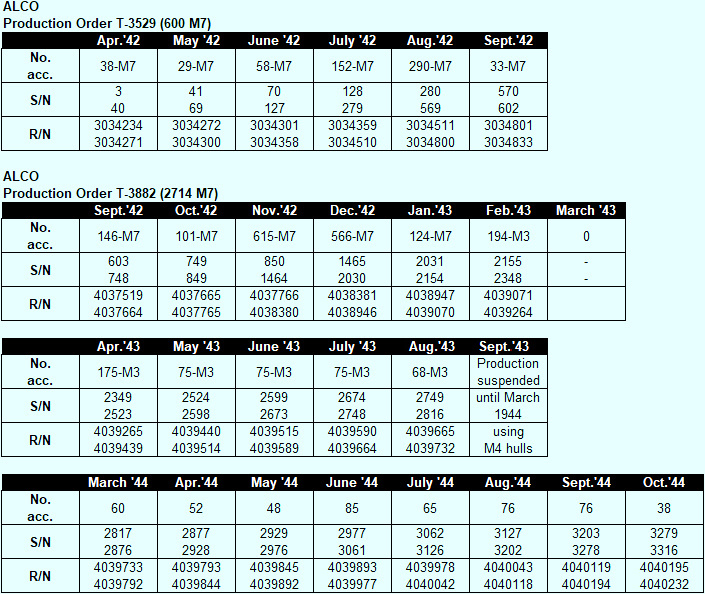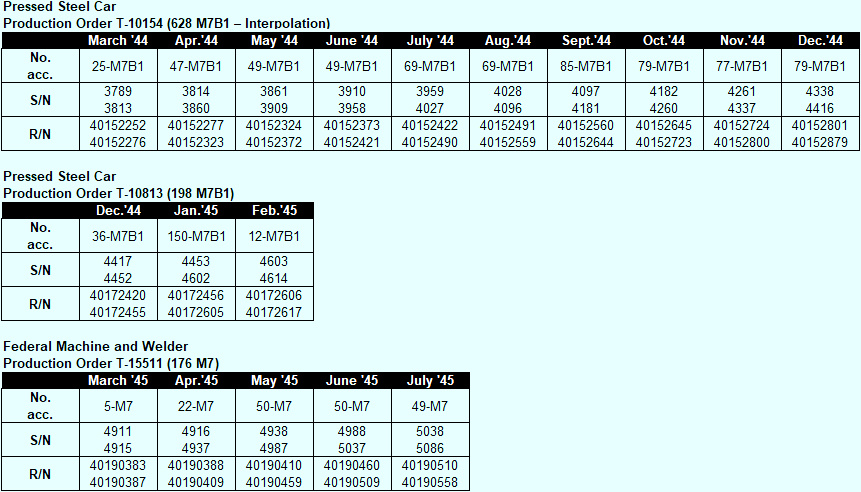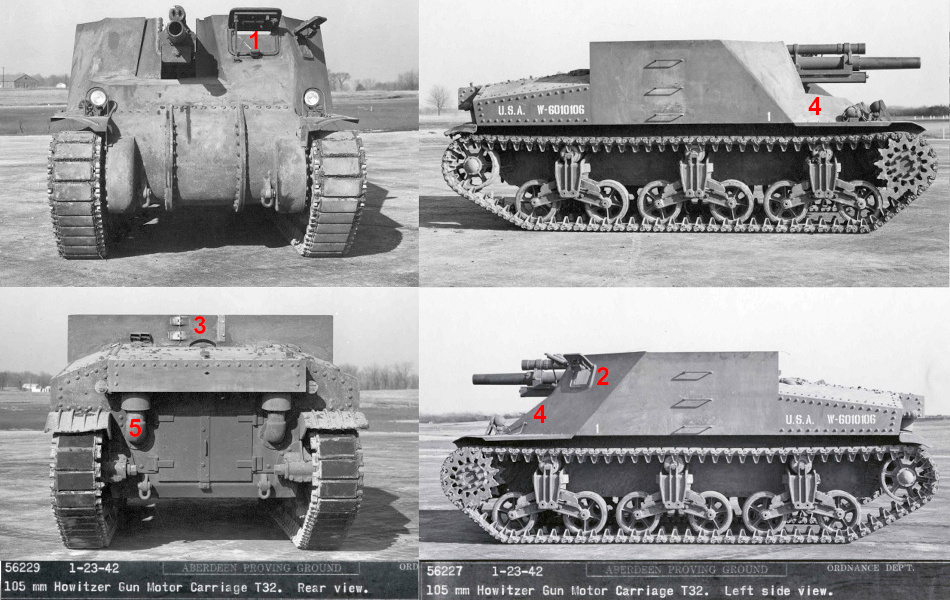 T32 Number 1 was shipped to the Armored Force Board at Fort Knox,
Kentucky where it was evaluated in early February 1942. Both the T19 [M3
Half Track conversion] and the T32 were equipped with the M2A1 105mm
Howitzer which could "throw a 33-pound shell 12,000 yards [`7 miles].
The AFB found the T32 design to be greatly superior to the T19 and
recommended that it be produced as the standard artillery piece of the
Armored Field Artillery Battalion. However, the Board did suggest that a
number of changes be made before it was placed into production.
T32 Number 1 was shipped to the Armored Force Board at Fort Knox,
Kentucky where it was evaluated in early February 1942. Both the T19 [M3
Half Track conversion] and the T32 were equipped with the M2A1 105mm
Howitzer which could "throw a 33-pound shell 12,000 yards [`7 miles].
The AFB found the T32 design to be greatly superior to the T19 and
recommended that it be produced as the standard artillery piece of the
Armored Field Artillery Battalion. However, the Board did suggest that a
number of changes be made before it was placed into production.
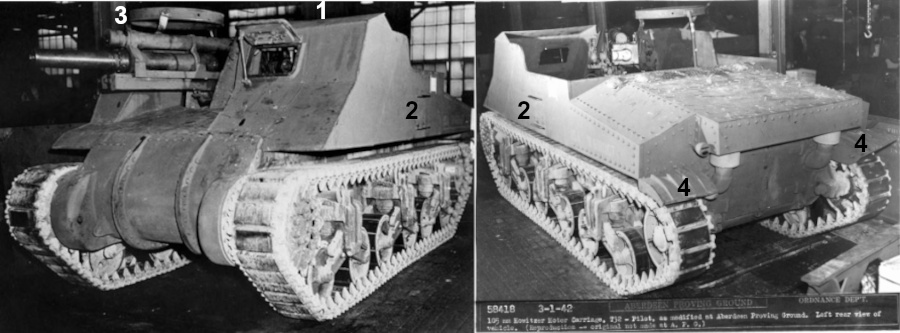
Back in the shops at APG, the superstructure of T32 Number 2, USA
6010107 was substantially reconfigured to address the recommendations of
the Armored Force Board. First of all, the sides were altered so that
they no longer angled in at the front. This resulted in the elimination
of the pistol port/protectoscope and provided more room in the fighting
compartment where seats were installed for the seven-man crew. The
ammunition stowage was increased from 44 to 57 rounds. A small "awning"
(1) 3 inches high, was added to the top of the front plate on the left.
The sides of the superstructure were stepped down by 11 inches and the
rear plate was eliminated. With the lowering of the sides, the number of
ladder rungs (2) was reduced to 2 per side. A ring mount (3) for a .50
caliber antiaircraft machine gun was rather crudely installed at the
right front corner. The howitzer was repositioned a little further to
the right to permit a traverse of 15 degrees left and 30 degrees right.
The vehicle retained the M3's riveted upper hull in the rear along with
the rubber mud flaps (4), but the straightening of the superstructure's
sides forced the removal of the Lee type front fenders along with the
headlights and siren. These photos are dated 1 March 1942, and soon
thereafter, T32 Number 2 was shipped to the American Locomotive Company
in Schenectady, New York. At that time, ALCO was building M3 and M3A1
Lee Medium Tanks at an average rate of less than 100 units per month,
even though the plant had a monthly capacity of 575 units. Consequently,
the firm was given a contract for the production of 600 105mm Howitzer
Motor Carriages, standardized as the "M7." T32 Number 2 was provided to
ALCO for use as a full-sized working model.
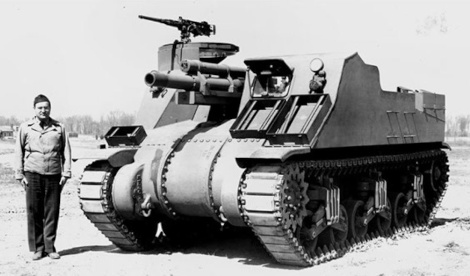
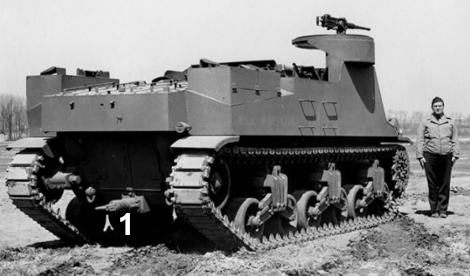
Things moved rather quickly, and ALCO engineers refined the design and
cranked out the first 38 M7s in April 1942. The first two, Serial
Numbers 3 and 4 were shipped to APG for evaluation. The photos above are
dated 8 April 1942 and show Serial Number 4, USA 3034235, which is
described as the "First Production Vehicle"; presumably SN 3 was
considered ALCO's production pilot. As a rule, US Army Registration
Numbers beginning with "30" denoted "tanks" but for some reason, the
first 600 M7 Howitzer Motor Carriages were assigned tank RNs 3034234
through 3034833. The lines of the vehicle look very much like T32 # 2,
but it can be seen that the entire upper hull is now composed of welded
armor plate. The armor was reduced from 3/4 inch to 1/2 inch at the
request of the Armored Force Board. It is assumed this was to save
weight, while still protecting the crew from small arms fire and
shrapnel. According to the Technical Manual, the M7 had a fully equipped
weight, including 7-man crew, of 52,000 pounds. For comparison, the
"fighting weight" of the M3 Lee was recorded as 61,500 pounds, and the
M4 and M4A1 Shermans as slightly less than 67,000 pounds. The lower hull
was "still" the riveted construct of the M3 Medium "with same thickness
[1 1/2 inch] as on Medium Tank M3 or M4 - either armor or soft plate
giving minimum ballistic effectiveness of 1/2" armor." We interpret this
to mean that after a while, 1 1/2-inch soft plate was used provided it
had the same ballistic properties as 1/2-inch armor. The ring mount for
the .50 caliber antiaircraft machine gun was neatly supported by a
semicircular armored housing. The upper rear hull plate appears to cover
more of the pepper pot exhaust, so it may have been lowered by a few
inches when compared to the T32. Notice that it goes straight across at
the bottom. This would be changed somewhat with the introduction of the
improved R-975-C1 engine. A trailer towing pintle (1) was installed from
the start. About a year later, this same "long" pintle was ordered to
be factory installed on the Sherman series. The number of "grip
bars...which serve as ladders to the crew compartment" was increased
from 2 to 4 per side. The M3 Lee type rear rubber mud flaps were
replaced with sheet metal fenders and new fenders were fashioned to fit
the lines of the M7's front. Three grouser boxes were attached to the
front plate and the siren and head lights were mounted high up on the
glacis, perhaps not the ideal position from the driver's standpoint.
These items were not protected by guards at the beginning. The inclusion
of rear stowage bins was part of the M3 Grant but not the original M3
Lee design. The M7's designers must have recognized their value. At
first, the M7's bins were hinged to open to the sides because the tops
were installed with fittings intended to hold auxiliary fuel tanks.
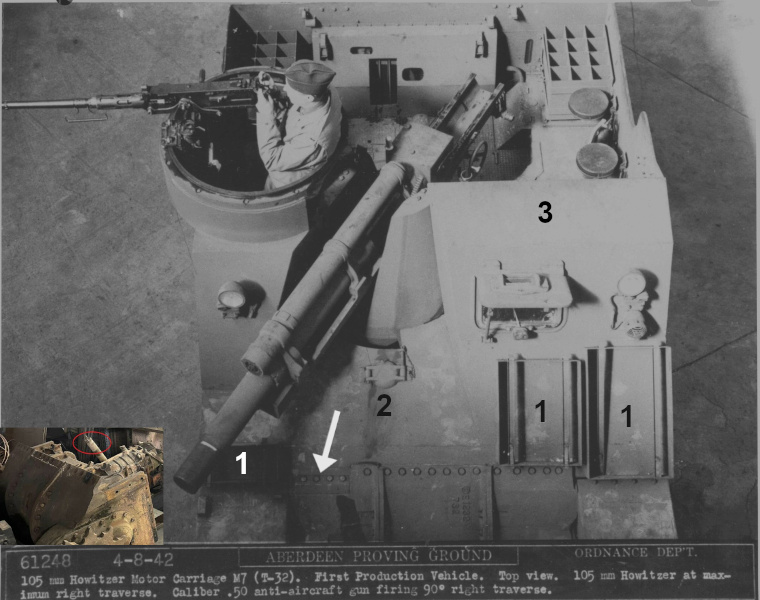 The photo above, again dated 8 April 1942, shows SN 4 posed with the
"105mm howitzer at maximum right traverse." The M7 Technical Manual has
it that the vehicle was equipped with 26 "Grouser[s] to match track
furnished." These were stored "In boxes (1) on front of vehicle." From
largest to smallest, the boxes held 13, 10 and 3 grousers. Period photos
suggest that the grouser boxes remained open from start to finish. We
mention that because when grouser boxes were factory installed on the M3
Lee series starting in May 1942, they included lids. Due to the way the
armor angled in below the howitzer, engine oil for the Power Train
Lubrication System could not be added easily from inside the vehicle, so
an extended filler pipe (inset) was attached to the transmission. The
filler point was protected by an armored fuel cap (2) and a dipstick was
included for checking the oil level. What we called the "awning" (3)
added on to T32 #2 was intended to provide a bit of overhead protection
for the driver. To our eyes, it appears to have been made a few inches
wider on SN 4. The first M7s were outfitted with "Medium M3 Power
Train[s]" on which the right side of the 3-piece differential housing
was notched in (arrow) to match the odd lines of the M3's hull.
Obviously, the "notch" was not necessary on the M7. The "Medium M4 Power
Train" in both one and three-piece versions began to enter the
production pipeline as the Sherman program got underway in the Spring of
1942, and these "unnotched" models would soon replace the M3
powertrains on the M7. SN 4 appears to be "as shipped" from ALCO in this
photo. It was outfitted with 3 fold down crew seats on each side of the
fighting compartment, two of which can be seen here. Also visible
against the firewall are two 12 round ammunition racks.
The photo above, again dated 8 April 1942, shows SN 4 posed with the
"105mm howitzer at maximum right traverse." The M7 Technical Manual has
it that the vehicle was equipped with 26 "Grouser[s] to match track
furnished." These were stored "In boxes (1) on front of vehicle." From
largest to smallest, the boxes held 13, 10 and 3 grousers. Period photos
suggest that the grouser boxes remained open from start to finish. We
mention that because when grouser boxes were factory installed on the M3
Lee series starting in May 1942, they included lids. Due to the way the
armor angled in below the howitzer, engine oil for the Power Train
Lubrication System could not be added easily from inside the vehicle, so
an extended filler pipe (inset) was attached to the transmission. The
filler point was protected by an armored fuel cap (2) and a dipstick was
included for checking the oil level. What we called the "awning" (3)
added on to T32 #2 was intended to provide a bit of overhead protection
for the driver. To our eyes, it appears to have been made a few inches
wider on SN 4. The first M7s were outfitted with "Medium M3 Power
Train[s]" on which the right side of the 3-piece differential housing
was notched in (arrow) to match the odd lines of the M3's hull.
Obviously, the "notch" was not necessary on the M7. The "Medium M4 Power
Train" in both one and three-piece versions began to enter the
production pipeline as the Sherman program got underway in the Spring of
1942, and these "unnotched" models would soon replace the M3
powertrains on the M7. SN 4 appears to be "as shipped" from ALCO in this
photo. It was outfitted with 3 fold down crew seats on each side of the
fighting compartment, two of which can be seen here. Also visible
against the firewall are two 12 round ammunition racks.
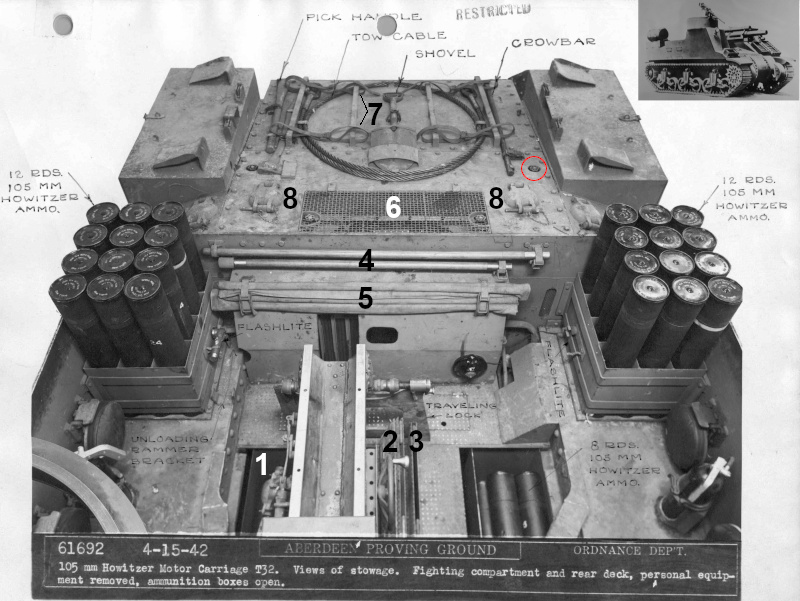 This view was taken on 15 April 1942 and shows SN 4 equipped with
various items of stowage. Most of these are neatly labeled and
self-explanatory. We believe that the 105mm ammunition stowage seen here
is the "as built" 57 rounds arrangement. Not labeled are the 25 rounds
that were stored in a compartment (1) directly below and to the right of
the gun breach. The ammunition under the tread plate floor was covered
over with multi-hinged doors (2 & 3). The "poles" affixed to the
upper firewall held the two staffs of "Brush, bore, M12" (4) and those
attached directly to the metal guard over the Transmission Oil Cooler
held "Rammer, cleaning and unloading, M5" (5). The engine deck panels
appear to be nearly identical to the M3 Medium's, with the same tool and
tow cable stowage, 4 fuel tank shut off valves (one circled) and the
air intake (6) protected only by a metal screen. However, 4 new "rails"
and straps (7) were added. The Technical Manual states that they held
"Net, camouflage, cotton shrimp, 45-ft X 45-ft." The armored fuel filler
covers (8) are the M3 type with the "short and straight" locking pins
instead of the angle pins used on the Sherman series. The photo provides
a good view of the chutes and other fittings for the auxiliary fuel
tanks. In one of the 8 April 1942 photos of SN 4 there is a handwritten
note, "No Jettison Tank Brackets" suggesting that it had been determined
that these wouldn't be used. That may be why the inset is the only
photo we have encountered that shows one of the Jettison Tanks
installed. Aside from this, if these auxiliary fuel tanks were ever
mounted, tested, or shipped with any M7s, we have yet to come across any
reports or photos. According to the Technical Manual, the M7 had a
cruising range of 168 miles and a fuel capacity of 176 gallons, so it
took a bit more than a gallon of gas for the vehicle to go 1 mile. In
any case, counting heads suggests that the fittings for the auxiliary
fuel tanks were eliminated in September 1942, at which point the M7 was
installed with what appear to be the same top opening stowage bins that
were introduced in production on the M3 Lee around June 1942.
This view was taken on 15 April 1942 and shows SN 4 equipped with
various items of stowage. Most of these are neatly labeled and
self-explanatory. We believe that the 105mm ammunition stowage seen here
is the "as built" 57 rounds arrangement. Not labeled are the 25 rounds
that were stored in a compartment (1) directly below and to the right of
the gun breach. The ammunition under the tread plate floor was covered
over with multi-hinged doors (2 & 3). The "poles" affixed to the
upper firewall held the two staffs of "Brush, bore, M12" (4) and those
attached directly to the metal guard over the Transmission Oil Cooler
held "Rammer, cleaning and unloading, M5" (5). The engine deck panels
appear to be nearly identical to the M3 Medium's, with the same tool and
tow cable stowage, 4 fuel tank shut off valves (one circled) and the
air intake (6) protected only by a metal screen. However, 4 new "rails"
and straps (7) were added. The Technical Manual states that they held
"Net, camouflage, cotton shrimp, 45-ft X 45-ft." The armored fuel filler
covers (8) are the M3 type with the "short and straight" locking pins
instead of the angle pins used on the Sherman series. The photo provides
a good view of the chutes and other fittings for the auxiliary fuel
tanks. In one of the 8 April 1942 photos of SN 4 there is a handwritten
note, "No Jettison Tank Brackets" suggesting that it had been determined
that these wouldn't be used. That may be why the inset is the only
photo we have encountered that shows one of the Jettison Tanks
installed. Aside from this, if these auxiliary fuel tanks were ever
mounted, tested, or shipped with any M7s, we have yet to come across any
reports or photos. According to the Technical Manual, the M7 had a
cruising range of 168 miles and a fuel capacity of 176 gallons, so it
took a bit more than a gallon of gas for the vehicle to go 1 mile. In
any case, counting heads suggests that the fittings for the auxiliary
fuel tanks were eliminated in September 1942, at which point the M7 was
installed with what appear to be the same top opening stowage bins that
were introduced in production on the M3 Lee around June 1942.
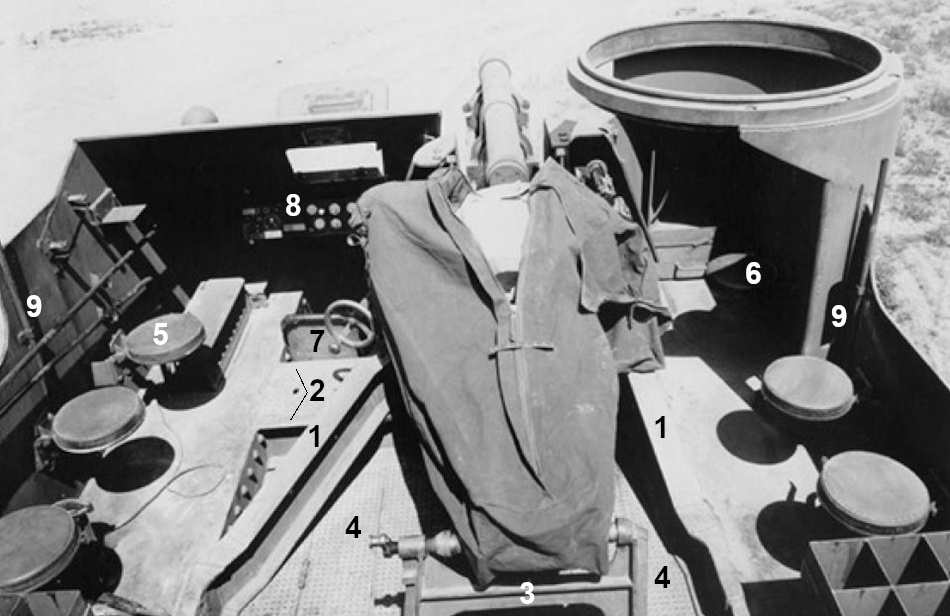
An overhead view looking to the front shows the attachment points (1) of
what are referred to as the "legs" of the 105mm howitzer. The body of
the gun sat on two cross beams (2) covered over with tread plate. The
gun traveling lock (3) is engaged in this instance. The tread plate
"floor" (4) beneath the gun held 33 105mm rounds that were accessed
through hinged folding doors. The engineers at APG determined to
increase the ammunition stowage from the original 57 rounds to 69 by
providing additional racks for 7 rounds along the left side of the
fighting compartment and 5 along the right. As a consequence, only the
left side fold down seat marked "5" and the machine gunner's seat marked
"6" were retained. The driver's seat (7) was mounted close to the side
of the lower hull. The instrument panel (8) was the same horizontal type
as used in the M3 Medium. At this time, APG was working on providing a
"Canvas top on the vehicle to completely enclose the fighting
compartment." Items 9 were the forward "uprights" of the support frame.
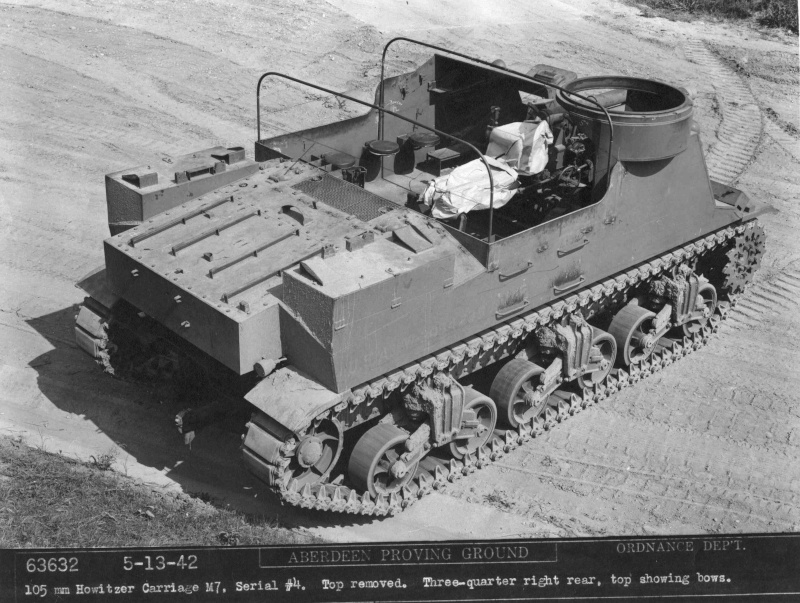
This view dated 13 May 1942 shows the uprights and top bows of the
canvas cover support frame installed. Some footman loops were added to
both sides which were used to secure the canvas top. Barely visible
here are some light pencil marks that appear to trace the outline of
the original T32 superstructure before the rear panel was eliminated
and the sides were reduced by 11 inches. Note that there are a pair of
diagonal lines that suggest a support for the rear panel. So, it would
seem, the engineers at APG were already thinking about reinstating the
height of the original superstructure in order to protect the partially
exposed rounds and the crew. Of course, when completed, this
modification included hinges to permit the panels to fold down.
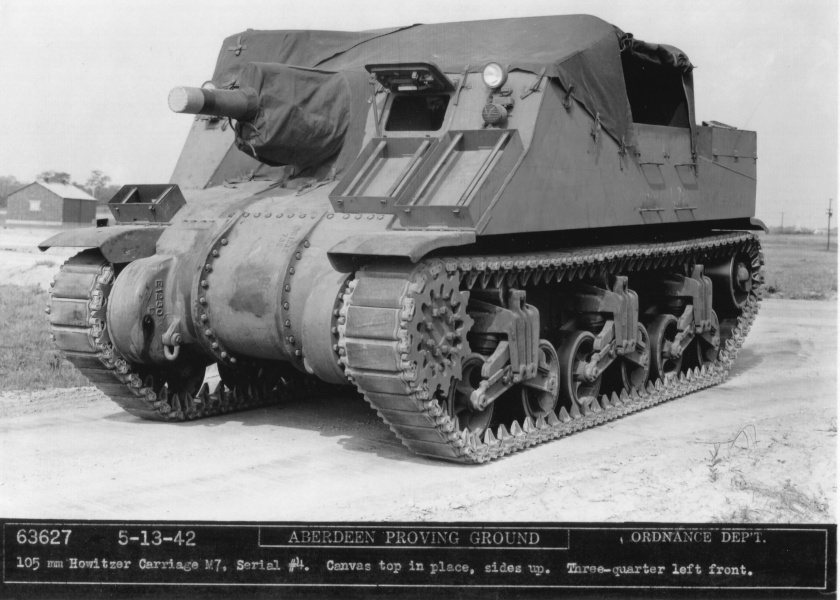
This
13 May 1942 view shows the "Canvas top in place, sides up." The top was
likely fashioned in the shops at APG or perhaps by a local sailmaker
since Aberdeen is right on the Chesapeake Bay. The top was strapped to a
number of footman loops positioned along the front, sides and rear. The
fittings to hold the support frame pieces had not yet been added when
this photo was taken.
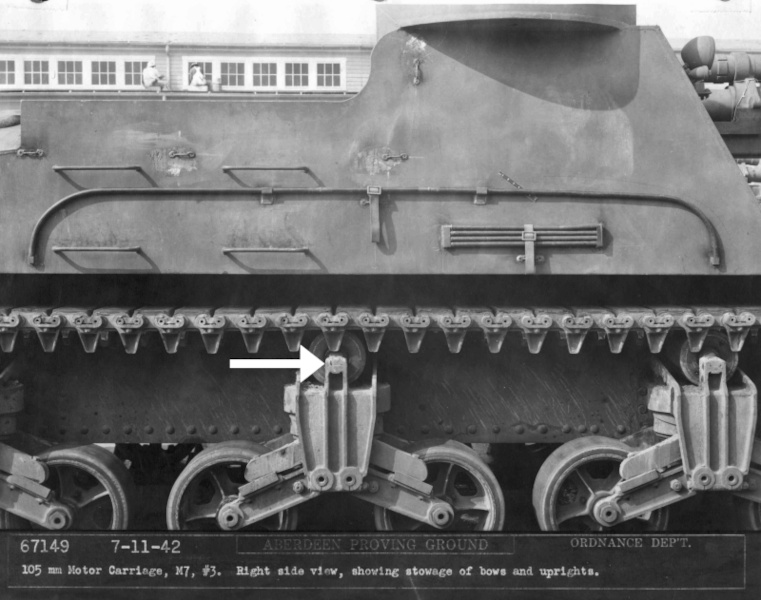 We have included the above photo dated 11 July 1942 simply because
it is the only one we know that identifies "105 mm Motor Carriage, M7,
#3". This shows the addition of the fittings for the "bows and uprights"
that made up the support frame of the canvas top. From the photo dates
it is obvious that APG was seriously working on the canvas top almost
from the start of production. The M7 project was given a high priority
rating, and the engineers at APG were refining the design on the fly
with the understanding that any changes made would not be permitted to
interfere with ongoing production. The M7 Technical Manual has it that
"A fabric top is provided for the vehicle to shelter the crew in case of
bad weather." This gives the impression that the top was supplied with
all or at least most M7s. However, it appears to us that it was not
factory installed until March 1944, when, after a half a year of
downtime, M7 production at ALCO resumed and was switched over to the use
of welded lower hulls, M4 type bogies only and other updated
features. Before that, we suspect the top may have been provided as a
modification kit for M7s already in combat zones or those headed to
combat zones. We don't have a copy of it at present, but a "Canvas Top"
Field Service Modification Work Order, G128-W15, was released in the
Spring of 1944. We can at least observe that the top or its fittings do
not show up in overseas photos until 1944. For future reference, note
that the M3 bogies' return rollers are in the original configuration
(arrow) without the spacer modification that would raise the rollers up
by about an inch.
We have included the above photo dated 11 July 1942 simply because
it is the only one we know that identifies "105 mm Motor Carriage, M7,
#3". This shows the addition of the fittings for the "bows and uprights"
that made up the support frame of the canvas top. From the photo dates
it is obvious that APG was seriously working on the canvas top almost
from the start of production. The M7 project was given a high priority
rating, and the engineers at APG were refining the design on the fly
with the understanding that any changes made would not be permitted to
interfere with ongoing production. The M7 Technical Manual has it that
"A fabric top is provided for the vehicle to shelter the crew in case of
bad weather." This gives the impression that the top was supplied with
all or at least most M7s. However, it appears to us that it was not
factory installed until March 1944, when, after a half a year of
downtime, M7 production at ALCO resumed and was switched over to the use
of welded lower hulls, M4 type bogies only and other updated
features. Before that, we suspect the top may have been provided as a
modification kit for M7s already in combat zones or those headed to
combat zones. We don't have a copy of it at present, but a "Canvas Top"
Field Service Modification Work Order, G128-W15, was released in the
Spring of 1944. We can at least observe that the top or its fittings do
not show up in overseas photos until 1944. For future reference, note
that the M3 bogies' return rollers are in the original configuration
(arrow) without the spacer modification that would raise the rollers up
by about an inch.
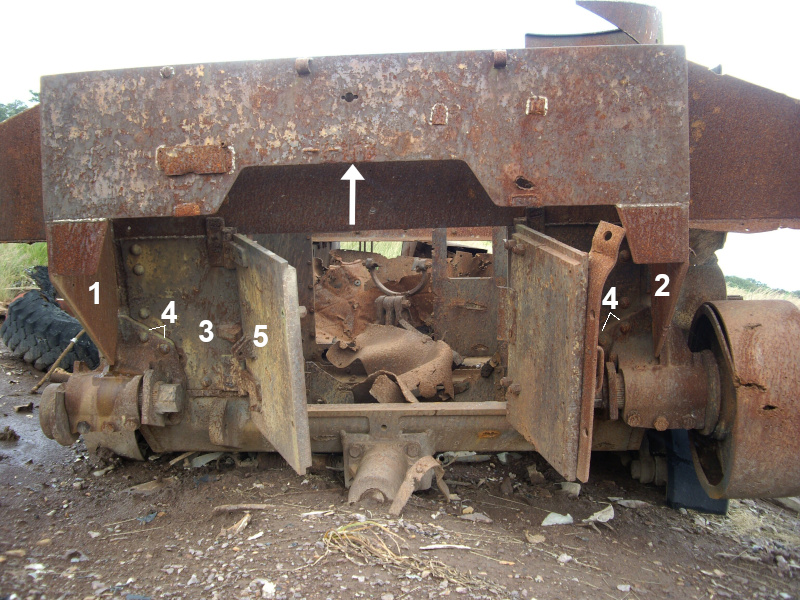
The only photos we have come across that show 105mm HMCs with the pepper
pot exhausts are the T32 pilots and M7 Serial Number 4. If any readers
have period photos of other examples, we'd be happy to see them. At
present, the earliest known surviving (of sorts) M7 is SN 124 seen on a
target range in France. It would be interesting to know the history of
this vehicle, but it has likely been lost to time. This unit would have
been accepted in June 1942, and it can be seen that it does NOT have
pepper pot holes. Thus, it could not have been built with an R-975-EC2
engine as original equipment. The profile of the M7's upper rear hull
was quite distinctive. Note how the rear hull plate, which went straight
across on the T32 pilots and M7 Serial Number 4, was jogged in (arrow)
to permit the mounting of the "high" exhaust pipes of the R-975-C1. With
the introduction of the improved engine, plates 1 and 2 were added to
support the externally mounted air cleaners, and a pair of bumpers (3)
were installed to protect the cleaners from being damaged by the engine
access doors. These are seen to have been mounted close to the lower
door hinges. On the riveted hull, the idler wheel assemblies were also
secured with rivets (4). This would have been inconvenient if service
was required, but this riveted attachment method appears to have been
used on the M7 until the lower hull was changed over to a welded
assembly starting in March 1944, at which point the idler wheel fittings
were bolted on as on Shermans. As a matter of minutia, we have observed
that the rivets seen on the lower hulls of surviving M7s are "round
head" rivets as opposed to conical rivets seen on some M3 Mediums, such
as those made by Chrysler. Fitting 5 indicates that at some point during
its service life, SN 124 was retrofitted with the Barber-Colman Exhaust
Deflector, an improvement that was introduced in M4/M4A1 Sherman
production in late 1943 and was also provided as a kit for Tank Depot
and field modification.

Some of the first M7s were obviously built with the R-975-EC2
engines, the same as some of the first M4A1 Shermans. The R-975-EC2
required 91 octane aviation gasoline and its odd pepper pot exhaust
configuration created some performance problems. At the request of the
Ordnance Department, Continental Motors redesigned the engine to run on
80 octane fuel and incorporated a number of improvements to increase
engine efficiency and horsepower. The new R-975-C1 engines were just
entering the manufacturers' pipeline as M4A1 and M7 production ramped up
in the Spring of 1942, and, of course, this would be the standard
engine of these models with its "final approved type of air cleaners and
muffler installation." We can get something of a clue about the number
of M7s that were built with R-975-EC2 engines from some correspondence
of Major Paul Tanner, the Army Inspector of Ordnance at ALCO. Tanner had
overseen the installation of a prototype canvas cover on SN 107/USA
3034338, and he reported that the unit had been shipped to APG on 27
June 1942 with the note, "This vehicle equipped for 91 octane gas all
future M7 vehicles to have 80 octane motors." Aberdeen did Acceptance
Tests of many different types of AFVs to determine "the general quality
level of these vehicles and to obtain an insight into any weaknesses of
design which could be noted through mechanical inspections, 500 miles of
operation and a functional firing test of the vehicular armament." One
such test was done on SN 122, built 2 units before the range wreck M7 of
the previous caption. A brief digest notes that it was powered with the
Continental R-975-EC2, so perhaps Major Tanner's "all future M7
vehicles [above SN 107] to have 80 octane motors" was not perfectly
accurate. In any case, we suspect that the transition was completed by
the end of June 1942. The photo above is dated 4 July 1942 and shows a
little of SN 107 at APG. The caption highlights the "One-piece final
drive." The Caterpillar Tractor Company was contracted to manufacture
powertrains, and like Buick and Ford, they began production with
one-piece final drives, Part Number E4186. In an attempt to move away
from the final drives notched for the M3 Medium, the Ordnance Department
appears to have supplied ALCO with some of these, along with Iowa
Transmission Co. Medium M4 Power Trains with unnotched three-piece final
drives.
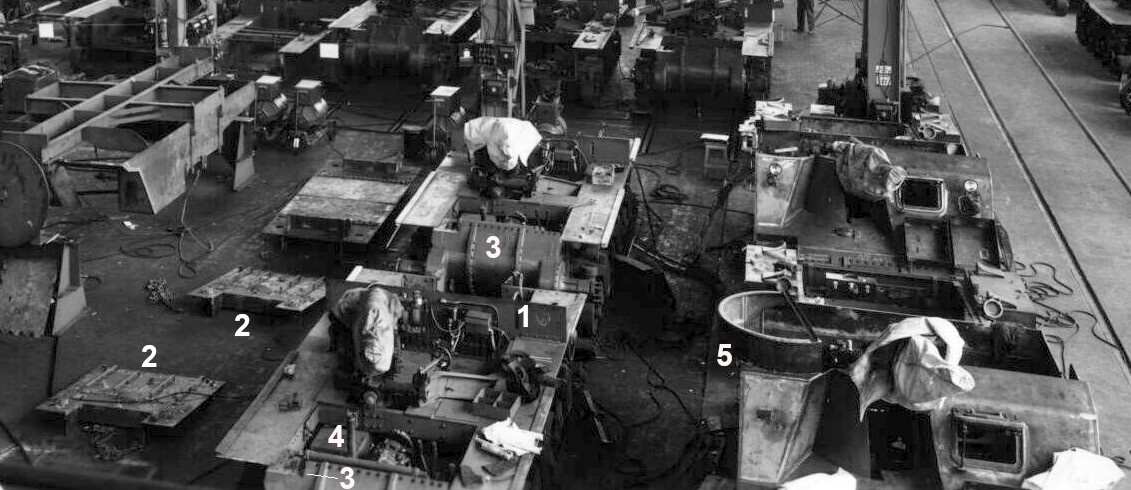 This undated photo shows the M7 assembly hall at ALCO. It is part of a
much larger image, but we have zoomed in to examine some details. The
number "65" (1) can be seen chalked on the firewall of the chassis on
the left front. We take this to indicate that it is the 65th M7 under
assembly. Considering the myriad components needed to convert the M3
Medium to a 105mm Motor Carriage, the ALCO people worked expeditiously
on this project, and to their great credit, had completed 67 units by
the end of May 1942. Thus, we might assume that this photo was taken in
April or May. The 2 sets of engine deck panels (2) can be seen in the
same configuration as on SN 4 with the added attachment rails for the
camouflage net. The visible powertrains are "still" protected with the
M3 type "notched" differential housings (3). Note the extended oil
filler pipe (4) attached to the transmission. The semicircular armored
housing (5) for the .50 caliber antiaircraft machine gun mount has been
added to the unit at the right front, but not the one directly behind
it. The British thought that this looked like a church pulpit and dubbed
the M7 the "Priest" and the name stuck. It seems like a pretty good bet
that some of the units in this photo were dispatched to the British in
Egypt as part of the "Emergency Shipment" of Shermans in mid-July 1942.
This undated photo shows the M7 assembly hall at ALCO. It is part of a
much larger image, but we have zoomed in to examine some details. The
number "65" (1) can be seen chalked on the firewall of the chassis on
the left front. We take this to indicate that it is the 65th M7 under
assembly. Considering the myriad components needed to convert the M3
Medium to a 105mm Motor Carriage, the ALCO people worked expeditiously
on this project, and to their great credit, had completed 67 units by
the end of May 1942. Thus, we might assume that this photo was taken in
April or May. The 2 sets of engine deck panels (2) can be seen in the
same configuration as on SN 4 with the added attachment rails for the
camouflage net. The visible powertrains are "still" protected with the
M3 type "notched" differential housings (3). Note the extended oil
filler pipe (4) attached to the transmission. The semicircular armored
housing (5) for the .50 caliber antiaircraft machine gun mount has been
added to the unit at the right front, but not the one directly behind
it. The British thought that this looked like a church pulpit and dubbed
the M7 the "Priest" and the name stuck. It seems like a pretty good bet
that some of the units in this photo were dispatched to the British in
Egypt as part of the "Emergency Shipment" of Shermans in mid-July 1942.
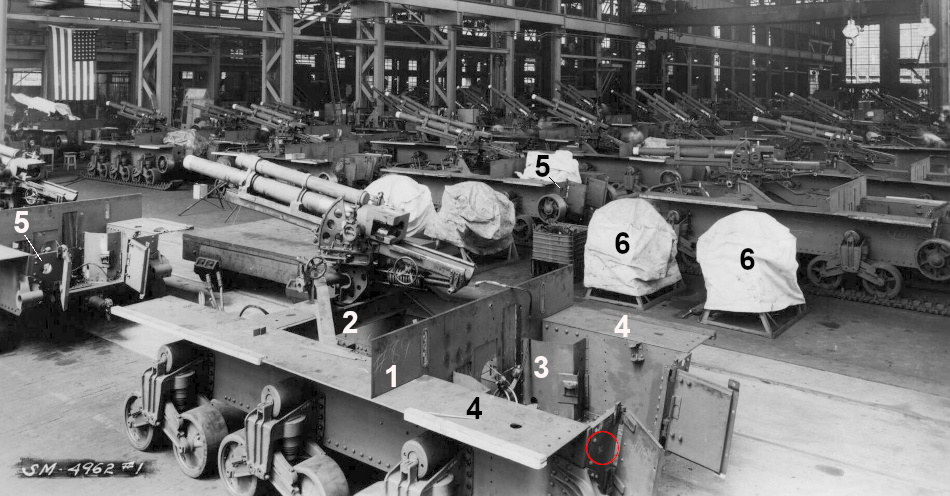 This photo was taken on the same day, but from the other end of the
assembly hall. The chassis in the foreground can be seen with "89" (1)
chalked on the firewall. Again, assuming that is a build sequence
number, the 89th M7 would have been accepted in June 1942. A pair of
what appear to have been I-beams (2) bridged the lower hull and
supported the howitzer. Two fuel tanks were mounted vertically in the
forward corners of the engine compartment. Item 3 is the shroud that
covered the right-side tank. Horizontal fuels tanks were mounted along
the sponsons at positions 4. Note that #89 has pressed metal road wheels
(5) installed, which suggests that ALCO received supplies of those as
well as the welded spoked wheels practically from the start. Most of
these units can be seen with the pepper pot holes (6) required for
R-975-EC2 engines. However, that doesn't seem to be the case with #89.
Perhaps the hole (circled) was welded up in this instance in
anticipation of the installation of the R-975-C1 engine? Unfortunately,
the radial engines (7) are covered here, but the collector rings of the
EC2 would have had the exhaust outlets in the "low" position for
attachment to the pepper pot exhaust, whereas the C1 would have had the
exhaust outlets at the top of the engine. An "Action on Revisions" memo
dated 18 April 1942, states that those M4A1s built at Lima with
R-975-EC2 engines "will be changed at the intermediate depots." There is
nothing in the doc about M7s, but it would appear that the 100 or so
units built with R-975-EC2 engines were treated like late production M3
Mediums and required the so-called "Quick Fix" modification before
issue. This replaced the R-975-EC2's original air cleaners, which were
mounted inside the engine compartment, with a pair of new externally
mounted air cleaners such as seen on M4 and M4A1 Shermans. In addition,
the pepper pot exhaust was removed and replaced with a pair of fishtail
exhaust pipes running through the pepperpot holes. This modification
also included the provision to "install new carburetor jets" which we
think might have enabled the engine to run on 80 octane fuel. M7s with
the Quick Fix would not have needed to have their upper rear hull plates
jogged in to permit the mounting of the "high" exhaust pipes of the
R-975-C1 engine, but they would have needed a pair of door stops and the
plates required to attach and support the new air cleaners.
This photo was taken on the same day, but from the other end of the
assembly hall. The chassis in the foreground can be seen with "89" (1)
chalked on the firewall. Again, assuming that is a build sequence
number, the 89th M7 would have been accepted in June 1942. A pair of
what appear to have been I-beams (2) bridged the lower hull and
supported the howitzer. Two fuel tanks were mounted vertically in the
forward corners of the engine compartment. Item 3 is the shroud that
covered the right-side tank. Horizontal fuels tanks were mounted along
the sponsons at positions 4. Note that #89 has pressed metal road wheels
(5) installed, which suggests that ALCO received supplies of those as
well as the welded spoked wheels practically from the start. Most of
these units can be seen with the pepper pot holes (6) required for
R-975-EC2 engines. However, that doesn't seem to be the case with #89.
Perhaps the hole (circled) was welded up in this instance in
anticipation of the installation of the R-975-C1 engine? Unfortunately,
the radial engines (7) are covered here, but the collector rings of the
EC2 would have had the exhaust outlets in the "low" position for
attachment to the pepper pot exhaust, whereas the C1 would have had the
exhaust outlets at the top of the engine. An "Action on Revisions" memo
dated 18 April 1942, states that those M4A1s built at Lima with
R-975-EC2 engines "will be changed at the intermediate depots." There is
nothing in the doc about M7s, but it would appear that the 100 or so
units built with R-975-EC2 engines were treated like late production M3
Mediums and required the so-called "Quick Fix" modification before
issue. This replaced the R-975-EC2's original air cleaners, which were
mounted inside the engine compartment, with a pair of new externally
mounted air cleaners such as seen on M4 and M4A1 Shermans. In addition,
the pepper pot exhaust was removed and replaced with a pair of fishtail
exhaust pipes running through the pepperpot holes. This modification
also included the provision to "install new carburetor jets" which we
think might have enabled the engine to run on 80 octane fuel. M7s with
the Quick Fix would not have needed to have their upper rear hull plates
jogged in to permit the mounting of the "high" exhaust pipes of the
R-975-C1 engine, but they would have needed a pair of door stops and the
plates required to attach and support the new air cleaners.
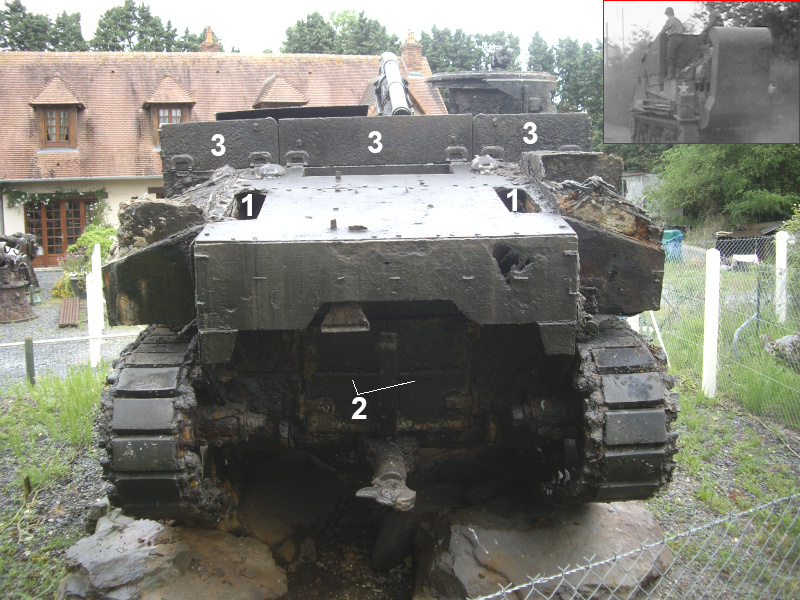 A problem that plagued the M3 Medium program was "Excessive
heating of gasoline." This created high pressures in the fuel tanks, and
"heating to the extent of melting the solder on gas tank covers." Of
course, this was a serious fire hazard. The designers of the M7 and
M4/M4A1 Shermans were aware of this and hoped that the introduction of
the R-975-C1 engine would lower the temperature inside the engine
compartment, particularly in hot weather conditions. In April 1942 just
as production was getting underway, Major Paul Tanner at ALCO was asked
to make observations and take readings of the conditions of 3 new M7s
[SNs 39, 40 and 41] and 4 new M3A1 Lees during their prescribed 50-mile
road tests. Before the 50 miles was reached, all of these were noted
with excessive fuel tank pressures and melted solder joints. It is
assumed that these vehicles were running with R-975-EC2 engines. Major
Tanner asked the engineers at APG to advise him "of any changes
necessary to prevent the over-heating of gasoline tanks." Aside from the
introduction of the improved engine, it was thought that greater air
flow within the engine compartment would help to ameliorate the
condition. On the M4 and M4A1, the solution was fairly simple - the
addition of a pair grouser compartment covers with air inlet grills. The
M4A4 also suffered from this issue, so the familiar "air scoops" were
added to these as well. The cooling abilities of the engines of the M4A2
and M4A3 Sherman models were such that they did not require air scoops.
Because the M7 had stowage bins, air scoops were not really an option,
so two rectangular holes (1) 6.5 by 20.5 inches were cut into the rear
engine deck as seen in the photo. These are shown on SN 2537, a May 1943
production M7 of the 58th Armored Field Artillery Battalion that was
lost at sea on D-Day when its transporting LCT struck a mine. This and a
number of other AFVs and D-Day artifacts recovered from the sea are on
display at the "Musée des Epaves Sous-Marines du Débarquement" in Port
en Bessin, France. The museum was created in the 1970s by a diver and
marine salvage professional named Jacques Lemonchois. The 58th AFA
Battalion's M7s would have been waterproofed for wading through the surf
up to 6 feet, and the line (2) running across the middle of the
lower rear hull plate shows where the exhaust pipes and air cleaners
would have been sealed in by a sheet metal structure with an exhaust
stack similar to that shown in the inset. Because they are so prevalent
in period photos, we suspect that the fold down panels (3) affixed to
the sides and rear of the superstructure were directed to be installed
by modification kit on all US Army M7s in the UK before D-Day.
A problem that plagued the M3 Medium program was "Excessive
heating of gasoline." This created high pressures in the fuel tanks, and
"heating to the extent of melting the solder on gas tank covers." Of
course, this was a serious fire hazard. The designers of the M7 and
M4/M4A1 Shermans were aware of this and hoped that the introduction of
the R-975-C1 engine would lower the temperature inside the engine
compartment, particularly in hot weather conditions. In April 1942 just
as production was getting underway, Major Paul Tanner at ALCO was asked
to make observations and take readings of the conditions of 3 new M7s
[SNs 39, 40 and 41] and 4 new M3A1 Lees during their prescribed 50-mile
road tests. Before the 50 miles was reached, all of these were noted
with excessive fuel tank pressures and melted solder joints. It is
assumed that these vehicles were running with R-975-EC2 engines. Major
Tanner asked the engineers at APG to advise him "of any changes
necessary to prevent the over-heating of gasoline tanks." Aside from the
introduction of the improved engine, it was thought that greater air
flow within the engine compartment would help to ameliorate the
condition. On the M4 and M4A1, the solution was fairly simple - the
addition of a pair grouser compartment covers with air inlet grills. The
M4A4 also suffered from this issue, so the familiar "air scoops" were
added to these as well. The cooling abilities of the engines of the M4A2
and M4A3 Sherman models were such that they did not require air scoops.
Because the M7 had stowage bins, air scoops were not really an option,
so two rectangular holes (1) 6.5 by 20.5 inches were cut into the rear
engine deck as seen in the photo. These are shown on SN 2537, a May 1943
production M7 of the 58th Armored Field Artillery Battalion that was
lost at sea on D-Day when its transporting LCT struck a mine. This and a
number of other AFVs and D-Day artifacts recovered from the sea are on
display at the "Musée des Epaves Sous-Marines du Débarquement" in Port
en Bessin, France. The museum was created in the 1970s by a diver and
marine salvage professional named Jacques Lemonchois. The 58th AFA
Battalion's M7s would have been waterproofed for wading through the surf
up to 6 feet, and the line (2) running across the middle of the
lower rear hull plate shows where the exhaust pipes and air cleaners
would have been sealed in by a sheet metal structure with an exhaust
stack similar to that shown in the inset. Because they are so prevalent
in period photos, we suspect that the fold down panels (3) affixed to
the sides and rear of the superstructure were directed to be installed
by modification kit on all US Army M7s in the UK before D-Day.
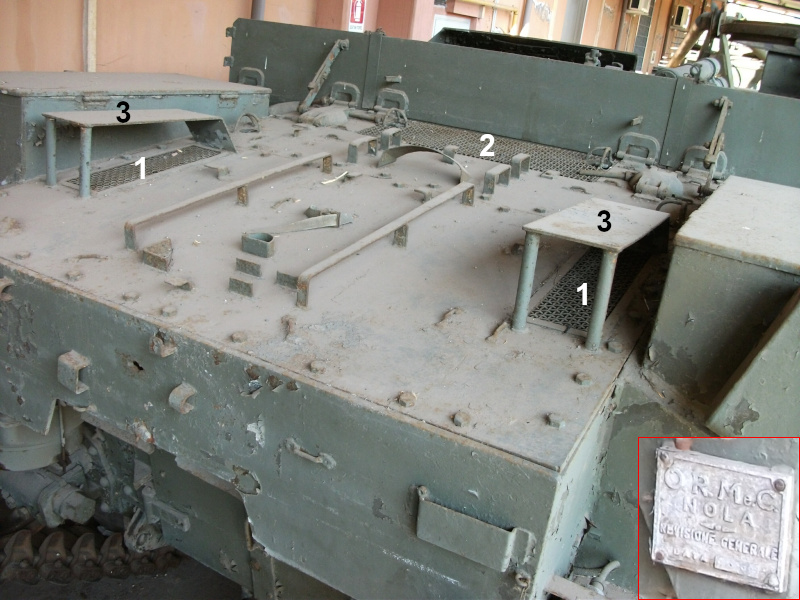
Here
we see the "fuel tank compartment ventilating grilles" (1) on SN 179
(July 1942) on display at the Museo della Motorizzazione Militare della
Cecchignola in Rome. It is thought that the framed screens on this
example are the originals. Like the air intake grille (2), these would
have made the engine compartment vulnerable to shrapnel damage, and a
pair of "grille protecting covers" (3) were placed above them. These
would also have served to keep the crew from piling things directly on
top of the ventilating grilles, thereby blocking the air flow. With the
addition of the grilles, the outside rails were removed, and a pair of
smaller rails were added on each side of the shovel fitting. The tow
cable was coiled through the middle of the smaller rails. The tool
storage was rearranged a bit with the axe moved to the upper rear hull
plate. Like most surviving M7s, SN 179 was modified and/or rebuilt
during the course of its service life. It has an Italian "Revisione
Generale" plate affixed to the rear (inset). Counting heads suggests
that this M7 would have been built with the side hinged stowage bins
with fittings for the auxiliary fuel tanks.
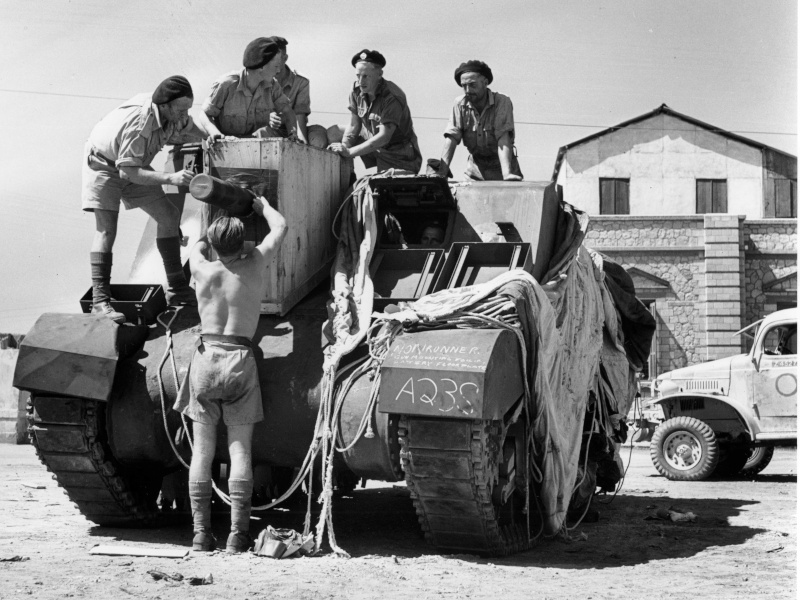 On 21 June 1942, Prime Minister Winston Churchill was at the White
House when he got the news of the surrender of Tobruk. President
Franklin Roosevelt asked if there was anything he could do to help, and
Churchill replied, "Give us as many Sherman tanks as you can spare and
ship them to the Middle East as quickly as possible." Churchill does not
appear to have asked for any M7s, but soon after, Roosevelt ordered the
shipment of 300 Shermans and 100 Priests. This would have been pretty
much the entire production of these vehicles up to that point. It is
reported that the "5185 Opportunity" convoy sailed on 15 July 1942 with
302 Shermans and 100 Priests. In the US documents, the Shermans break
down to 212 M4A1s and 90 M4A2s. The S.S. Fairport with 51 M4A1s and 32
Priests on board was sunk by a U-Boat the next day. The Seatrain Texas
sailed unescorted two weeks later with replacements of 52 M4A1s and 25
Priests. Thus, it would seem, 93 M7s made it to Egypt out of a total of
125 shipped. In his 2008 article in Military Modelling Magazine,
"Priests at El Alamein," Peter Brown cites the War Diary of No. 5 Base
Ordnance Depot at Tel-El-Kebir, where the unit reported that they
received a total of 100 Priests from September 5th through the 26th, so
we have a discrepancy of 7. The first “regular” Lend Lease shipment of
15 M4A2s “which had been intended to come well ahead...actually only
preceded [the emergency shipment] by a few days." Perhaps it included a
few Priests? In any case, a US "Report on Shipment 5185-ORD" has it that
100 "Carriage Motor 105 mm how. M7" were ordered from the Chester Tank
Depot on Shipping Order 2-G-2541. This was amended to increase the total
by 25 when the Fairport went down. It is thought that all of the M7s
that were not up to the current standard, that is, R-975-C1 or R-975-EC2
with Quick Fix, plus "ventilating grilles", were brought up to "spec"
at CTD. Also, the few available period photos suggest that they were
outfitted with US produced sand shields, which appear to be the same
type that were original equipment on most Grants. The Tank Depot System
in the US was just coming online at this time, and this was CTD's first
big "redball" shipping order. The Depot had about 3 weeks to process the
180 M4A1s and 100 Priests of the original order. (The Toledo Tank Depot
is reported to have processed the balance of the Shermans, including
all 90 of the M4A2s.) When the US first began shipping Lend Lease AFVs,
there were complaints that they were arriving at their destinations
damaged due to the incomplete sealing against the adverse effects of
salt water, high or low interior temperatures and humidity conditions
brought about by long sea voyages. One of the prime directives of the
new Tank Depots was to ensure that the vehicles arrived "ready for
issue." Chester Tank Depot pioneered this effort. A self-propelled gun
with a large open area such as the M7 presented a particular challenge,
and CTD encased the fighting compartment and the gun in wooden
structures. The Imperial War Museum photo above is dated 9 September
1942 and headlined "Latest American Tanks Arrive in Middle East." This
photo is part of a series that show the soldiers removing the "crate"
from the howitzer. The caption writer interpreted the sequence in
reverse with, "Some of the equipment of the new tanks, especially the
guns, is very secret and hence is covered up so that it cannot be seen
as the tanks proceed up towards the battle front." Likely the next stop
for this Priest would actually have been the No. 5 Base Ordnance Depot.
Courtesy of Imperial War Museum Photo E16614.
On 21 June 1942, Prime Minister Winston Churchill was at the White
House when he got the news of the surrender of Tobruk. President
Franklin Roosevelt asked if there was anything he could do to help, and
Churchill replied, "Give us as many Sherman tanks as you can spare and
ship them to the Middle East as quickly as possible." Churchill does not
appear to have asked for any M7s, but soon after, Roosevelt ordered the
shipment of 300 Shermans and 100 Priests. This would have been pretty
much the entire production of these vehicles up to that point. It is
reported that the "5185 Opportunity" convoy sailed on 15 July 1942 with
302 Shermans and 100 Priests. In the US documents, the Shermans break
down to 212 M4A1s and 90 M4A2s. The S.S. Fairport with 51 M4A1s and 32
Priests on board was sunk by a U-Boat the next day. The Seatrain Texas
sailed unescorted two weeks later with replacements of 52 M4A1s and 25
Priests. Thus, it would seem, 93 M7s made it to Egypt out of a total of
125 shipped. In his 2008 article in Military Modelling Magazine,
"Priests at El Alamein," Peter Brown cites the War Diary of No. 5 Base
Ordnance Depot at Tel-El-Kebir, where the unit reported that they
received a total of 100 Priests from September 5th through the 26th, so
we have a discrepancy of 7. The first “regular” Lend Lease shipment of
15 M4A2s “which had been intended to come well ahead...actually only
preceded [the emergency shipment] by a few days." Perhaps it included a
few Priests? In any case, a US "Report on Shipment 5185-ORD" has it that
100 "Carriage Motor 105 mm how. M7" were ordered from the Chester Tank
Depot on Shipping Order 2-G-2541. This was amended to increase the total
by 25 when the Fairport went down. It is thought that all of the M7s
that were not up to the current standard, that is, R-975-C1 or R-975-EC2
with Quick Fix, plus "ventilating grilles", were brought up to "spec"
at CTD. Also, the few available period photos suggest that they were
outfitted with US produced sand shields, which appear to be the same
type that were original equipment on most Grants. The Tank Depot System
in the US was just coming online at this time, and this was CTD's first
big "redball" shipping order. The Depot had about 3 weeks to process the
180 M4A1s and 100 Priests of the original order. (The Toledo Tank Depot
is reported to have processed the balance of the Shermans, including
all 90 of the M4A2s.) When the US first began shipping Lend Lease AFVs,
there were complaints that they were arriving at their destinations
damaged due to the incomplete sealing against the adverse effects of
salt water, high or low interior temperatures and humidity conditions
brought about by long sea voyages. One of the prime directives of the
new Tank Depots was to ensure that the vehicles arrived "ready for
issue." Chester Tank Depot pioneered this effort. A self-propelled gun
with a large open area such as the M7 presented a particular challenge,
and CTD encased the fighting compartment and the gun in wooden
structures. The Imperial War Museum photo above is dated 9 September
1942 and headlined "Latest American Tanks Arrive in Middle East." This
photo is part of a series that show the soldiers removing the "crate"
from the howitzer. The caption writer interpreted the sequence in
reverse with, "Some of the equipment of the new tanks, especially the
guns, is very secret and hence is covered up so that it cannot be seen
as the tanks proceed up towards the battle front." Likely the next stop
for this Priest would actually have been the No. 5 Base Ordnance Depot.
Courtesy of Imperial War Museum Photo E16614.
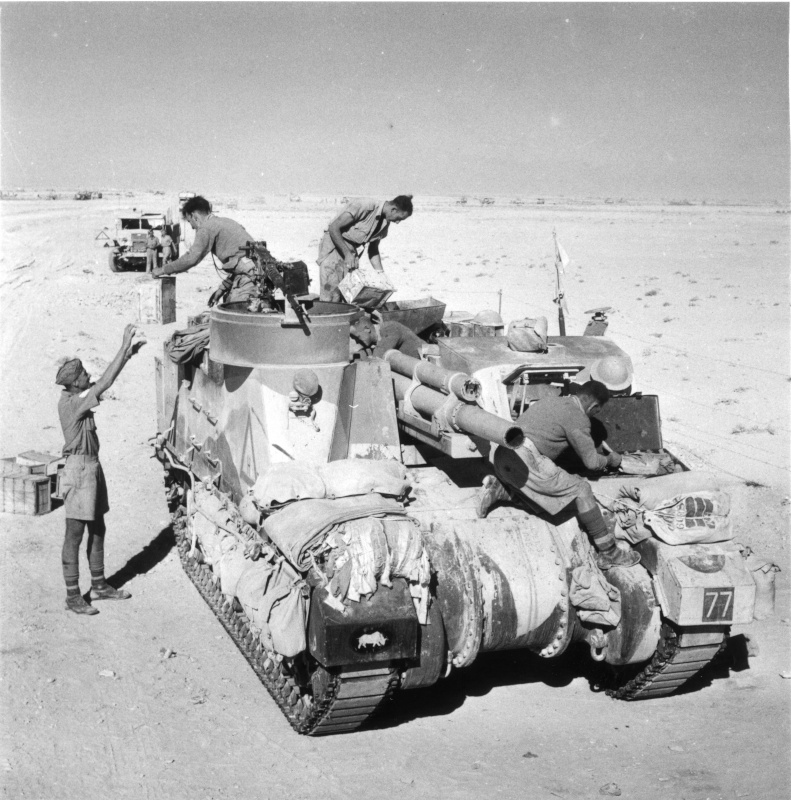
Like the Sherman, the M7 Priest had its combat debut with
the British at the Second Battle of El Alamein which began on 24 October
1942. In his article, Peter Brown references the War Diary of the 11
(Honourable Artillery Company) Regiment, Royal Horse Artillery which
states that they began to receive M7s in mid-September and had 24 on
strength at the start of the campaign. The regiment, which was
rebuilding after having suffered severe losses in previous battles,
appears to have been chosen to "test drive" the Priests, and had only a
few weeks to learn the ins and outs of the new machines. The 11th HAC
was composed of 3 batteries (A, B and E) with each battery having 2
troops of 4 M7s. During the battle, each of the 3 batteries supported an
armoured regiment of the 2nd Armoured Brigade, 1st Armoured Division.
Peter Brown has it that "'A' Battery worked with The Queen's Bays, 'B'
Battery with 10th Royal Hussars and 'E' Battery with 9th Queen's Royal
Lancers." The Imperial War Museum photo above is dated 2 November 1942
and is part of a series highlighting an M7 with British War Department
Number "S169306." The "triangle" tactical symbol seen painted on the
side was typically used to denote A Squadron, or in this case, A
Battery. Before issue, it would appear that the Regiment's Priests were
repainted, and modified with sunshade fittings, along with a storage bin
with lid which replaced the original grouser boxes on the left front.
Note the empty fitting retrofitted on the M7's "awning" and another just
behind it and to the right. These appear to be antenna brackets. The
No. 19 radio required two aerials, but they are not mounted here, which
suggests that installation of the radio was considered but perhaps not
actually implemented in this case. Also visible here is a sun compass
mounted on a fitting next to the pennants. This M7 can be seen with the
"notched" M3 Medium type differential housing. Courtesy of Imperial War
Museum Photo E18870.
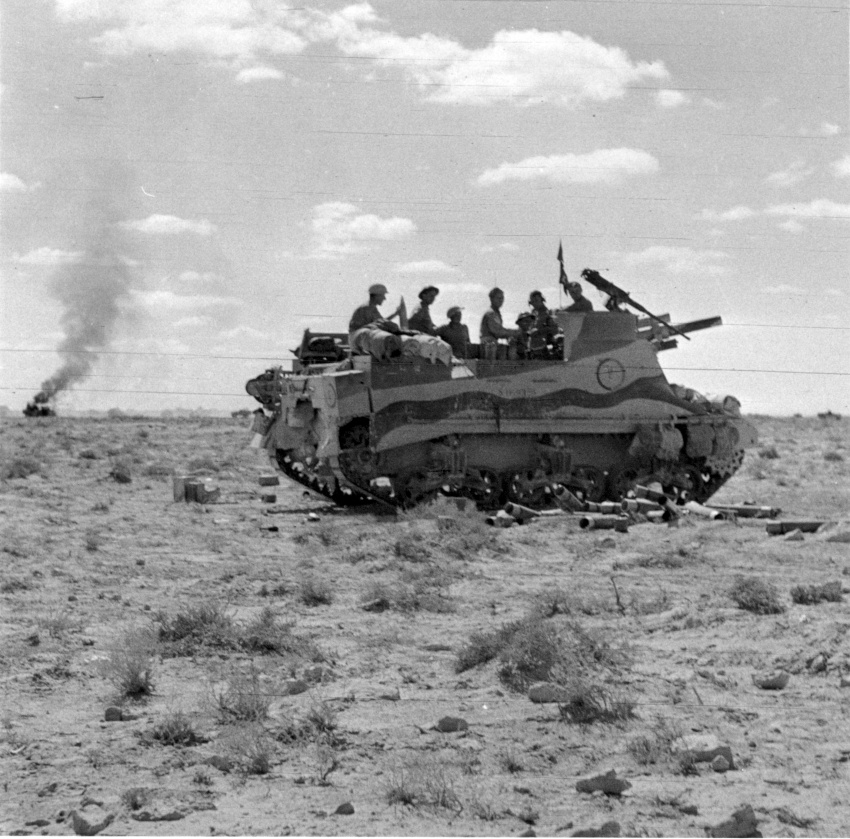
The photo above is dated 6 November 1942 and captioned, "General Priest
firing on enemy." (At some point, "the Priest" seems to have been
promoted to a General.) This is one of the few images of the "Alamein"
M7s that shows the rear of the vehicle, and it can be seen with a
"notched" upper rear hull plate which we take to be an indication that
it was powered by an R-975-C1 engine with the "high" exhaust pipes. This
same scene with the smoking wreck of what is presumed to be an enemy
vehicle in the background appears in the 1943 motion picture "Desert
Victory." In the movie, this M7 is seen with the pulpit on the left side
of the hull. Perhaps the producers reversed the film so that the
audience would know that the Eighth Army was attacking west? There is
some thought that the Priests were received by the 11th HAC in a single
color, which several authors describe as "light stone" or "light mud",
and that the unit itself painted on the darker colors before the battle.
Speculation is that the darkest color along the lower portion was black
and that the upper dark color was brown. The "circle" tactical symbol
seen here generally denotes "C", but in this case, it may have been used
as the symbol for "E" Battery, which for arcane reasons, was the third
Battery of the 11th HAC. Courtesy of Imperial War Museum Photo E19106.

After
2 weeks of intense fighting, the Eighth Army broke through the Axis
defenses, sending Panzerarmee Afrika into full scale retreat. This IWM
photo is dated 13 November 1942 and headlined, "More Pictures After the
Enemy Retreat." The caption describes the vehicle in an interesting way,
"The General Priest tank, a 105 m.m. self-propelling gun mounted on a
Grant tank chassis." The War Department Number can be seen as "S169299"
and the "triangle" tactical symbol suggests an M7 of A Battery. This
Priest is laden with a LOT of gear, but period photos suggests that two 5
gallon jerrycans with fittings were added to the left rear when the
Priests were processed for issue. The round object just above the
jerrycan appears to be a cable reel for hardwired telephone
communications. We suspect that this was added in the field. Overall,
the artillerists of the 11th HAC were pleased with the performance of
the M7, although there is the impression that some might have preferred
the same vehicle with the British 25 pounder gun, and indeed, that would
come later. Courtesy of Imperial War Museum Photo E19482.
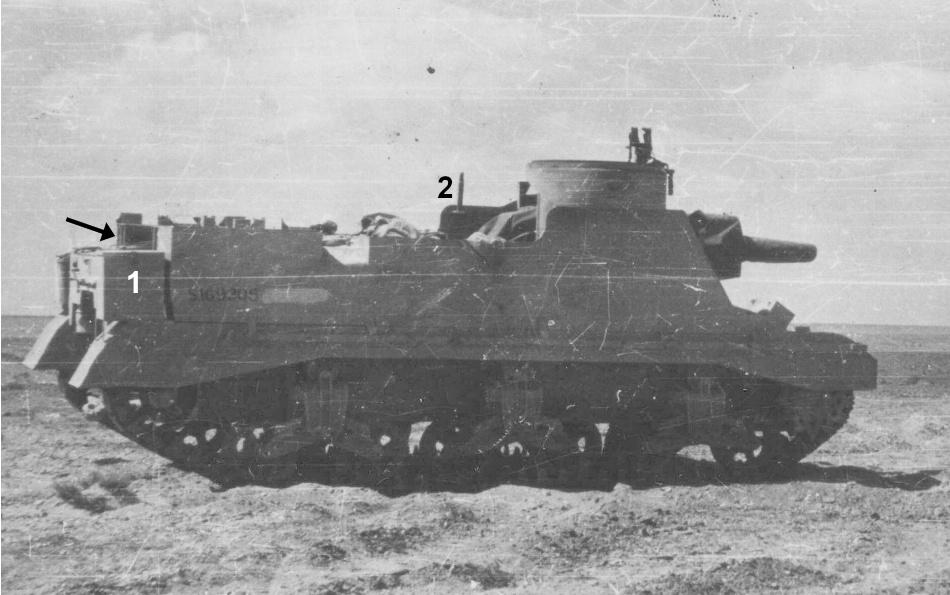
This
photo is captioned, "This weapon is on display at the American
maintenance school, Heliopolis repair depot, Ordnance, 9/42 Egypt." The
photographer is listed as "Maj Jarrett." Major George Burling Jarrett
was the director of the US Middle East Training Center which had been
established in May 1942 to train members of the British armored corps in
the maintenance of US tanks and self-propelled guns. Somehow, one of
his snapshots "became" part of the Signal Corps collection - SC237536.
Of course, Jarrett's school would have needed a few M7s to accomplish
its mission. Although the quality is poor, it is the only Alamein era
Priest photo we know of at present where one of the "grille protecting
covers" (arrow) is visible. In addition, this unit can be seen with a
"notched" upper rear hull plate which we take to indicate an R-975-C1
engine. It is thought that the stowage box on the right rear (1) was
retrofitted when the Priests were processed for issue since they show up
in the few period photos where the rear is visible. Again, it can be
noted that the antenna base (2) does not have an aerial installed. This
M7 has what looks to be "S169305" painted on in a dark color. The WD
Numbers appear to have been applied after the Priests arrived in
Egypt. In the realm of "counting heads", we have collected 22 WD Numbers
from photos and reports that fall in a range from S169282 through
S169388, encompassing about 106 units.
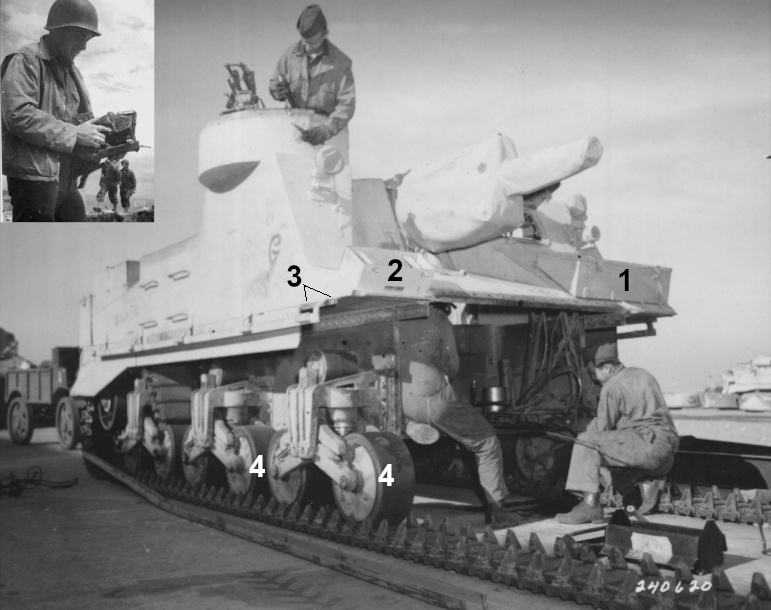
Here we have a Signal Corps photo taken by an actual SC photographer.
The caption reads, "Tank crew make "100hr" check on an M1 (sic) "Priest"
at Heliopolis Repair Depot, Egypt. Jan. 1943" This is likely to have
been one of the training M7s at the US Maintenance School at Heliopolis.
Note that there appear to be a bunch of turrets and a Grant tank in the
background on the right. The GIs working on the Priest were no doubt
stationed at the school. The photo provides a good idea of the
appearance of the stowage bin (1) that the Brits substituted for the
grouser boxes but note that they did retain the small grouser box (2).
The US supplied sand shields were attached to an "L" bracket (3), part
of which is visible here. This Priest can be seen with pressed metal
road wheels (4). We have shown that these could be original, but at this
point, the unit's wheels along with everything else had probably been
installed, uninstalled and replaced many times. The few photos show
these training Priests in a single color, which several authors describe
as "light stone." We believe the vehicles' original factory olive drab
was painted over in this light color when the M7s were processed for
issue at the No. 5 Base Ordnance Depot. At the same time, the War
Department number was painted on in a dark color. Sorry to say we could
not quite make out "S-Number" of this unit from the original print at
the US Archives. As an open top vehicle, the Priest's interior was
factory painted olive drab as opposed to the white used on Sherman
interiors. The British might have repainted the interiors, but in this
view, the lower hull interior seems to be a darker shade, but perhaps
that is just shadows. The photo is credited to " Sgt. W.F. Lovell."
Sergeant Warden F. Lovell went on to serve with the 165th Signal Photo
Company and landed at Pointe du Hoc with the 2nd Ranger Battalion on
D-Day. He had his camera shot out of his hands (inset). He was awarded
the Distinguished Service Cross for his actions on that day.
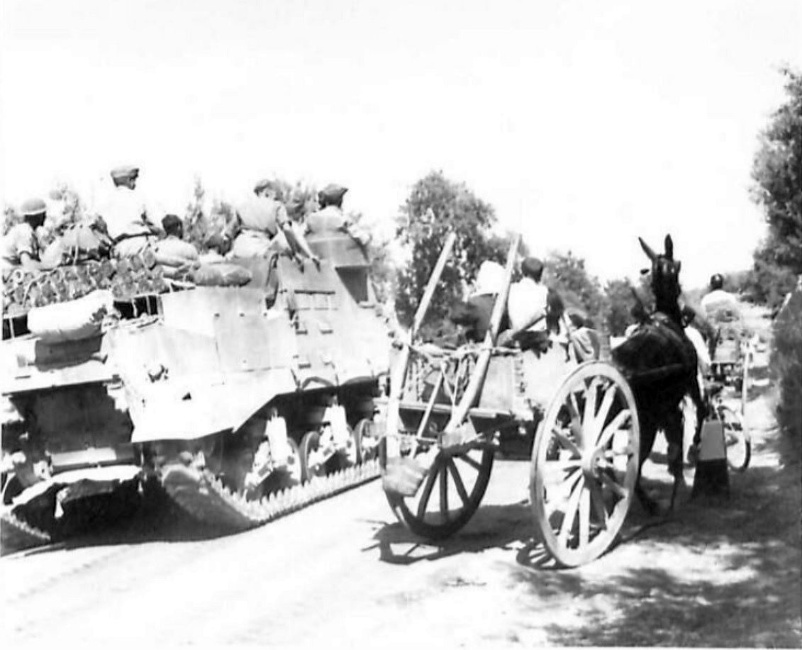
By April 1943, the joint US/UK Munitions Assignment Board had allocated
299 M7s to Commonwealth Lend Lease. It was reported that 137 were
already in the Middle East along with 2 in the United Kingdom. The
remaining 160 units were on the way from the US. Of those, 84 were
allocated to India. The other 76 were more than likely assigned to the
Middle East. As a matter of curiosity, the MAB documents note that there
were 10 "Howitzer 105mm T19" in the Middle East in April 1943 as well.
The T19 was the expedient design on which a 105mm was mounted on an M3
half-track. This was, of course, rejected as the standard self-propelled
105mm gun mount in favor of the M7. We assume that the T19s were sent
for comparison with the M7, but oddly, the "British Empire" is not
officially listed as having received any T19s as Lend Lease. The 2 M7s
in the U.K. might have been early "preview" models, such as "Michael"
the second production Sherman, which was preserved and is currently on
display at the Tank Museum at Bovington. If so, like "Michael" one or
both may have been shipped with their original R-975-EC2 engines with
pepper pot exhaust. However, we have not as yet come across any test
reports or other references to those. Despite the small numbers involved
in the campaign in North Africa, the performance of the Priest was such
that the 11th HAC and a newly converted unit, the 98th Field Regiment
(Surrey & Sussex Yeomanry Queen Mary's), were assigned to take part
in the Sicilian Campaign. This Imperial War Museum photo is dated 11
July 1943, the second day of the invasion, and shows a Priest advancing
"to contact the enemy nr. NOTO." This unit does not appear to be
camouflage painted, so may have been an M7 of the 98th Field Regiment.
An IWM film dated 19 July, shows "The Queens Royal Regiment with Priest
guns in Sicily." In the footage, the color of some of the M7s
looks closer to olive drab than light stone to our eyes. Of interest in
the photo above is that the upper rear hull plate is not "notched" for
the "high" exhaust pipes, which would suggest that this M7 was equipped
with the R-975-EC2 engine with the "Quick Fix" exhaust and air cleaner
modification. The sun can be seen glinting off the exhaust pipe below
the air cleaner on the left side. It would appear that a piece of metal
or wood had been placed across the "grille protecting covers" to hold a
number of 105mm rounds. A few photos such as this, suggest that "flaps"
were added in the field to raise the height of the sides and rear of the
crew compartment. Note the rubber chevron tracks. This is obviously an
early M7 which we suspect was part of the "Emergency shipment." A few
modelers have asked about the rear configuration of the "Alamein"
Priests. We can't do much more than guess that some were shipped with
standard R-975-C1 engines and others with R-975-E2s with the "Quick
Fix." Courtesy of Imperial War Museum Photo NA4309.
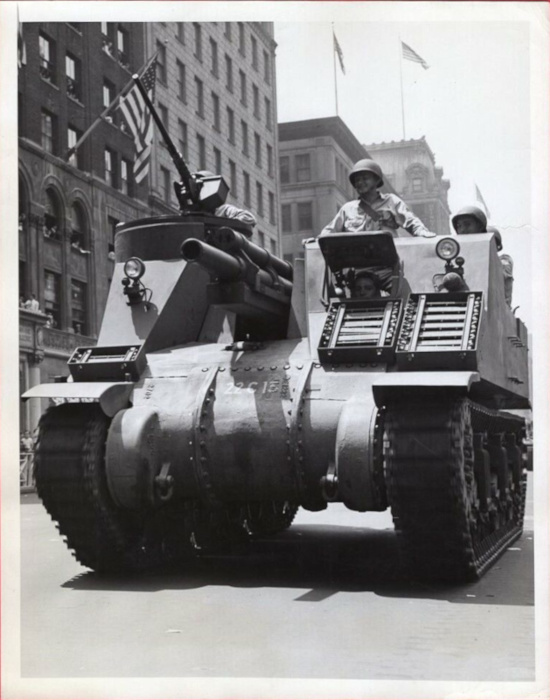 The
Emergency shipment to the British delayed the distribution of the new
M7s to US troops and some units were issued the expedient half-track
mounted T19s in the meantime. The photo above is the earliest one we
have encountered showing M7s in the hands of US troops. This Priest was
photographed as it paraded up Fifth Avenue during the massive "New York
at War" Parade held in New York City on 13 June 1942. By mid-June, ALCO
would have produced about 100 M7s. From February through August 1942,
ALCO also manufactured 300 cast hull M3A1 Lees, and we were especially
interested in studying the NYC parade footage for our M3 Lee Page since
visible tactical markings show that the 4th Armored Division's 35th and
37th Armored Regiments participated with at least 14 of the relatively
rare M3A1s. In any case, we might assume that the "22" painted on the
center of the Priest's M3 Lee type differential housing would indicate
the 22nd Armored Field Artillery Battalion of the 4th AD. At the time,
the 4th AD was stationed at Pine Camp, New York (now Ft. Drum) which was
about 150 miles northwest of the ALCO plant in Schenectady, and it
seems likely that some brand new M3A1s and perhaps a few M7s were
shipped to them in time to show off at the parade.
The
Emergency shipment to the British delayed the distribution of the new
M7s to US troops and some units were issued the expedient half-track
mounted T19s in the meantime. The photo above is the earliest one we
have encountered showing M7s in the hands of US troops. This Priest was
photographed as it paraded up Fifth Avenue during the massive "New York
at War" Parade held in New York City on 13 June 1942. By mid-June, ALCO
would have produced about 100 M7s. From February through August 1942,
ALCO also manufactured 300 cast hull M3A1 Lees, and we were especially
interested in studying the NYC parade footage for our M3 Lee Page since
visible tactical markings show that the 4th Armored Division's 35th and
37th Armored Regiments participated with at least 14 of the relatively
rare M3A1s. In any case, we might assume that the "22" painted on the
center of the Priest's M3 Lee type differential housing would indicate
the 22nd Armored Field Artillery Battalion of the 4th AD. At the time,
the 4th AD was stationed at Pine Camp, New York (now Ft. Drum) which was
about 150 miles northwest of the ALCO plant in Schenectady, and it
seems likely that some brand new M3A1s and perhaps a few M7s were
shipped to them in time to show off at the parade.
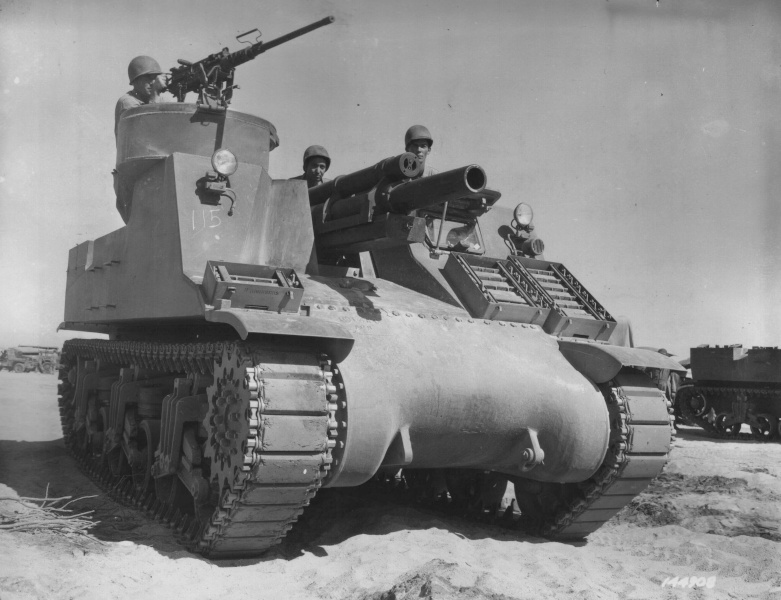
The photo above is dated 19 September 1942, and the caption heralds "the
Army's newest tank destroyer." Somehow, even before the Priest had
entered combat, the idea had gotten around that the mount was a "tank
killer" and it doesn't seem to have been discouraged by the higher ups. A
few M7s were "being tested for desert warfare at Iron Mountains,
California" [the Desert Training Center]. Some other photos taken at
Iron Mountain on the same day by the same photographer, "Musser", show
mostly Lees but some Shermans of the 33rd Armored Regiment, 3rd Armored
Division, so it may be that the Priests were assigned to one of the
Armored Field Artillery Battalions of the 3rd AD. The number "115"
chalked on may or may not be the M7's Serial Number or perhaps a build
sequence number. If so, either would indicate June 1942 production and
the early appearance of the vehicle does not contradict that. Note that
"3 Grousers" is stenciled on the smallest grouser box. The next box held
10 grousers and the largest held 13 for a total of 26. The grouser
boxes were changed a bit over time, but these represent the original,
factory configuration as installed on 1942/43 production M7s. "Musser"
the photographer was likely Technician Fourth Grade Arland B. Musser of
the 163rd Signal Photographic Company. Just from the examination of some
other Signal Corps photos credited to him, we would guess that he was
"embedded" with the 45th Infantry Division during his time overseas. He
took some harrowing images of the Dachau Concentration Camp in late
April 1945.

Several photos of "Finalist" are notable for being in color. The
image above was also provided in black and white as SC163844-B with the
caption, "M7-105mm-Howitzer Antitank Artillery Piece at Armored Force,
in Fort Knox, Kentucky, 2-1-43 [1 Feb 1943]." The color photos must have
lost their original captions by the time they were turned into the
Pentagon in the postwar years since they are generic and uninformative,
with one having "Place Not Known" and "date not known." Again, we have a
reference to "Antitank" in the caption of the b/w photo. While the
105mm gun was certainly capable of killing a tank, that is not the role
that Gen. Devers envisioned for the M7. "Finalist" can be seen with the
Registration Number USA 3034487 painted on in a dark color, probably
black. This would indicate that it was accepted in July 1942. By July,
counting heads suggests that ALCO would have been factory installing
R-975-C1 engines and "fuel tank compartment ventilating grilles." Note
that this unit has pressed metal road wheels. Six of the seven-man crew
are visible with the driver assumed to be down in his seat out of view.
Oddly, this M7 does not appear to be carrying any onboard 105mm
ammunition and we would assume that two of the cannoneers are sitting on
the ammunition holders on the right. A few companies are listed so we
thought readers might be interested in the APG description of an M7
produced a month later, "Howitzer Motor Carriage #548, USA #3034779,
manufactured by the American Locomotive Company, is a self propelled
mount for the 105 MM Howitzer M2A1, #4239, manufactured by the United
Engineering and Foundry Company. The Howitzer is mounted centrally in a
lightly armored upper hull of a Medium Tank M4 [sic] chassis; powered by
a Continental R975-C1 engine Serial No. 123761 and containing a
Caterpillar one piece transmission Serial No. 2C-286."
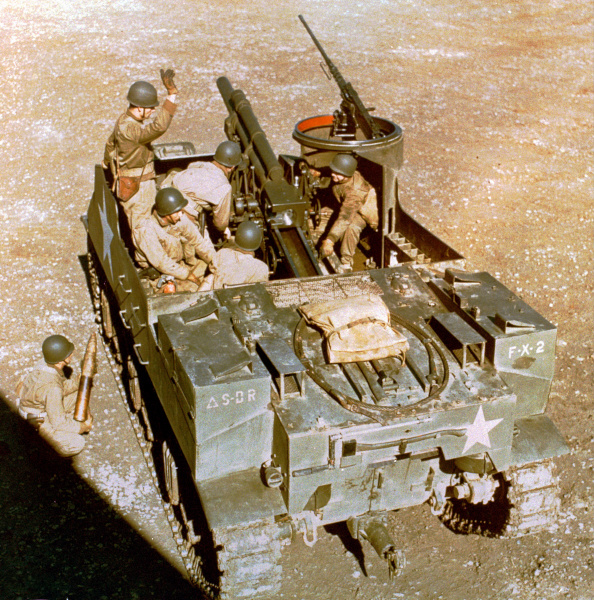 This
color view of "Finalist" taken from the rear shows the tactical
markings that we interpret as "Delta S" (Armored School), "DR"
(Demonstration Regiment), "F" (Field Artillery) and "X-2" (Separate
Company, Vehicle 2). The rear represents the appearance of an M7 built
with the R-975-C1 engine with the high mounted exhaust pipes which are
seen here just below the notch of the upper rear hull plate. According
to the Technical Manual, a "Net, camouflage, cotton shrimp, 45-ft X
45-ft" was strapped to the rails on the engine deck. On this example,
there appears to be a "Paulin, 12-ft X 12-ft" strapped to the rails.
When it was introduced or installed as a modification, the "Cover,
howitzer motor carriage, M7" is simply listed as "folded on rear deck."
An engine crank and axe are seen mounted to the upper rear hull plate.
By September 1942, the side opening stowage bins appear to have been
replaced with the same top opening bins that were introduced in
production on the M3 Lee around June 1942. Some period photos suggest
that at that point, the engine crank was moved to the lid of the
right-side bin, and an idler adjusting wrench was installed on the left
bin. One of the cannoneers can be seen outside the vehicle preparing to
hand up the next round. Indeed, photos suggest that the "action post"
for one or two of the cannoneers was often outside the fighting
compartment either on the ground or on the engine deck preparing the
next rounds.
This
color view of "Finalist" taken from the rear shows the tactical
markings that we interpret as "Delta S" (Armored School), "DR"
(Demonstration Regiment), "F" (Field Artillery) and "X-2" (Separate
Company, Vehicle 2). The rear represents the appearance of an M7 built
with the R-975-C1 engine with the high mounted exhaust pipes which are
seen here just below the notch of the upper rear hull plate. According
to the Technical Manual, a "Net, camouflage, cotton shrimp, 45-ft X
45-ft" was strapped to the rails on the engine deck. On this example,
there appears to be a "Paulin, 12-ft X 12-ft" strapped to the rails.
When it was introduced or installed as a modification, the "Cover,
howitzer motor carriage, M7" is simply listed as "folded on rear deck."
An engine crank and axe are seen mounted to the upper rear hull plate.
By September 1942, the side opening stowage bins appear to have been
replaced with the same top opening bins that were introduced in
production on the M3 Lee around June 1942. Some period photos suggest
that at that point, the engine crank was moved to the lid of the
right-side bin, and an idler adjusting wrench was installed on the left
bin. One of the cannoneers can be seen outside the vehicle preparing to
hand up the next round. Indeed, photos suggest that the "action post"
for one or two of the cannoneers was often outside the fighting
compartment either on the ground or on the engine deck preparing the
next rounds.
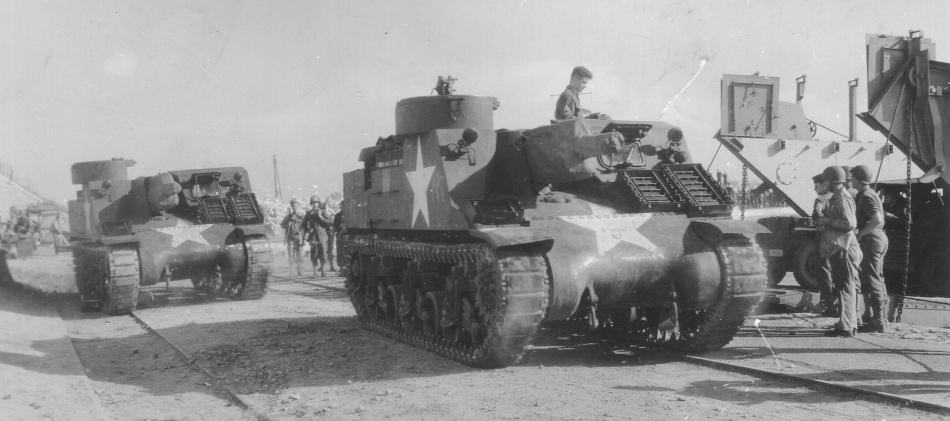
Combat Command B of the 1st Armored Division was assigned to the Center
Task Force of Operation Torch, the Allied Invasion of Northwest Africa.
The objective of the CTF was the capture of the major port of Oran in
Algeria. Units of the 1st Infantry Division began the assault with
support from CCB on 8 November 1942. Here is the earliest "combat zone"
photo of US Army M7s we know, dated "9 Nov 42", and captioned, "American
Medium Tanks [sic] are unloaded at a port in Algeria. 1st Armored Div.,
Combat Command B, at Arzew." It is thought that they would have
belonged to the 27th Armored Field Artillery Battalion which was a part
of CCB. Some sources have it that the 27th AFA Bn was equipped entirely
with T19 105mm Howitzer Motor Carriages, but this photo suggests that
they had at least 2 M7s. The fiberboard ammunitions containers would
hint that these Priests were "combat loaded", that is, ready to go into
action upon landing.
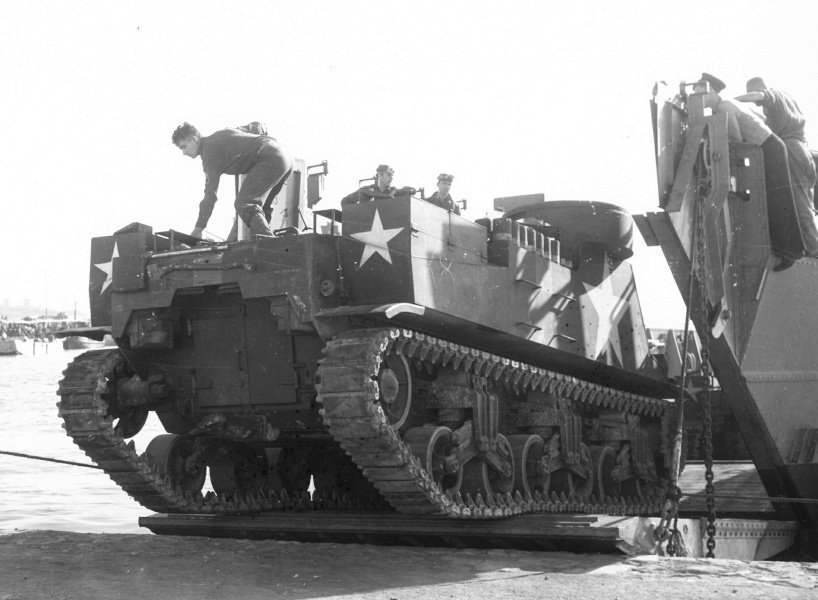 The same scene showing one of the M7s being offloaded from an L.C.T.
[Landing Craft Tank] at Arzew. "K8", perhaps some sort of shipping
reference, appears to be chalked on the side at both the rear and the
front. CCB histories mention that their light and medium tanks were
sealed in the UK for shallow water fording, but there is nothing to
indicate that this M7 had been waterproofed in any way. It is another
example seen with the "standard" rear hull configuration typical of the
R-975-C1 installation. The records of CCB simply refer to "105mm SP" so
it is not clear if the M7s engaged in combat on the 9th or 10th of
November before the French surrendered. Around mid-December 1942, the
officers of CCB were asked to submit recommendations based on their
experiences fighting in Algeria and Tunisia up to that point. There is a
specific reference, "One 105mm Howitzer on M7 carriage was put out of
action by having the forward end of the recoil cylinder punctured by
small arms fire. An armor plate shield should be installed to protect
the forward end of the recoil cylinder." So, it might be assumed that
CCB's combat debut of the M7 occurred at some point before mid-December.
Another recommendation concerned the vulnerability of the ammunition
stored vertically along the sides of the hull, "The side armor on
present models should be raised by welding on a strip of armor plate; in
new manufacture, the 10-inch cutaway on the sides should not be made.
The sides were originally designed with this piece cut away to
facilitate resupply of ammunition over the side. However, this advantage
is outweighed by the disadvantages of the increased jeopardy to the
howitzer and the crew."
The same scene showing one of the M7s being offloaded from an L.C.T.
[Landing Craft Tank] at Arzew. "K8", perhaps some sort of shipping
reference, appears to be chalked on the side at both the rear and the
front. CCB histories mention that their light and medium tanks were
sealed in the UK for shallow water fording, but there is nothing to
indicate that this M7 had been waterproofed in any way. It is another
example seen with the "standard" rear hull configuration typical of the
R-975-C1 installation. The records of CCB simply refer to "105mm SP" so
it is not clear if the M7s engaged in combat on the 9th or 10th of
November before the French surrendered. Around mid-December 1942, the
officers of CCB were asked to submit recommendations based on their
experiences fighting in Algeria and Tunisia up to that point. There is a
specific reference, "One 105mm Howitzer on M7 carriage was put out of
action by having the forward end of the recoil cylinder punctured by
small arms fire. An armor plate shield should be installed to protect
the forward end of the recoil cylinder." So, it might be assumed that
CCB's combat debut of the M7 occurred at some point before mid-December.
Another recommendation concerned the vulnerability of the ammunition
stored vertically along the sides of the hull, "The side armor on
present models should be raised by welding on a strip of armor plate; in
new manufacture, the 10-inch cutaway on the sides should not be made.
The sides were originally designed with this piece cut away to
facilitate resupply of ammunition over the side. However, this advantage
is outweighed by the disadvantages of the increased jeopardy to the
howitzer and the crew."
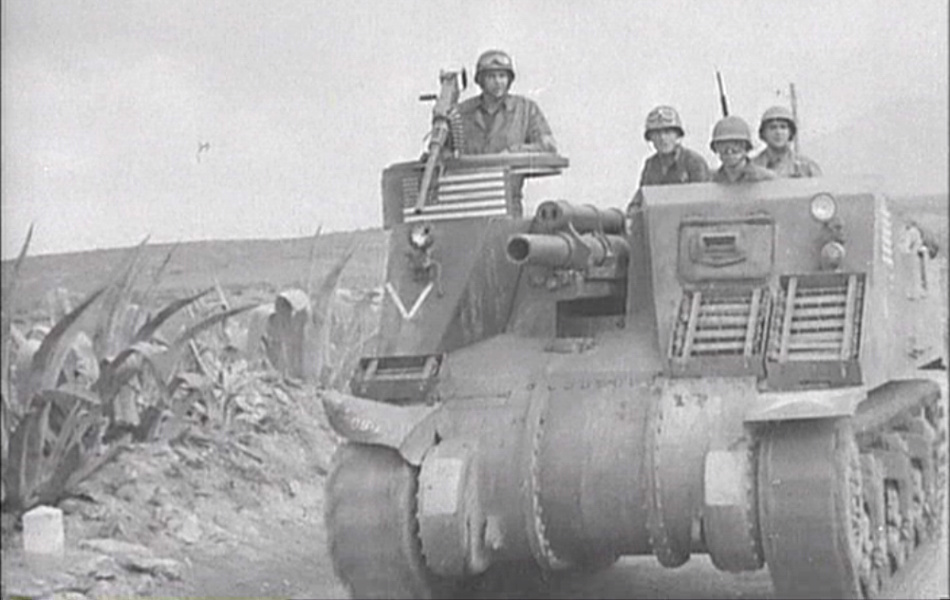
The image above is a screen capture from a United News (U.S. Office of
War Information) newsreel highlighting "Rommel's Defeat in
Africa" along with "U.S. Troops Enter French African Port of Oran." From
the context, it would appear that the Oran scenes were shot from the
invasion on 8 November 1942 to no later than the middle of the month.
While the 2 M7s unloading in Arzew are seen with one-piece differential
housings, this example has the "notched" three-piece diff made for the
M3 Medium. So, it would seem, the Center Task Force landed at least 3
M7s. The US flags on the front and side appear to have been paper prints
that were pasted on to the AFVs in the vain hope that if the French saw
them during the initial stages of the invasion, they would not fire.
The Western Task Force of Operation Torch landed on the Atlantic coast
of French Morocco with the goal of capturing the major port of
Casablanca. The landing at the minor port of Safi [Operation Blackstone]
was for the purpose of unloading the medium tanks so that they could
proceed to Casablanca 140 miles to the north as quickly as possible.
"The Armored Landing Team consisted of elements of CCB, 2nd Armored Division, including the
2nd and 3rd Battalions, 67th Armored Regiment (thirty-six light and
fifty-four medium tanks), supported by two batteries [12 units] of
self-propelled 105-mm. howitzers. The 3rd Bn of the 67th AR was made up
of 54 M4A1 Shermans according to some sources. We suspect there may have
been a few M4s in the mix. These would have been the first US Army
Shermans deployed to a combat theater. Because of their size, all of the
Shermans were shipped on the Seatrain Lakehurst. Battery B, 14th
Armored Field Artillery Battalion was also listed on the Lakehurst's
manifest. The port area of Safi was quickly captured on 8th November by
the 47th Infantry Regiment, 9th Infantry Division, permitting the
Lakehurst to dock and begin unloading the medium tanks at around 2 pm.
For what it is worth, in a paper he wrote in February 1947, Major F.M.
Muller, the Transport Quartermaster for the Lakehurst, mentions that
aside from the 54 medium tanks, "6 Carriage Motor M7's" were allocated
for transport. Also, "A History of the Second Armored Division
1940-1946" states that the Seatrain force "included the only medium
tanks, the only M-7 105 howitzers, and the only bridging unit in the
Western Task Force." So, perhaps some Priests landed at Safi. The
unloading of the Lakehurst was hindered by issues with cranes, sniper
fire and at least one aircraft attack, but in a May 1950 student
research report, "Armor in the Invasion of North Africa (2nd Armored
Division)", it is stated that "all of the vehicles of the 2d Armored
Division were finally unloaded from the sea train by 1700 hours [5 P.M.,
9 November]." On 9 November, D+1, General Ernest Harmon, commander of
the 2nd AD and of the Safi operation, ordered CCB to intercept French
reinforcements heading towards Safi on the highway from Marrakesh. It is
reported that the CCB column was "bombed and strafed" but that "the
attack was not too successful...due to dispersion of the vehicles." M5
Stuarts of the 2nd Bn, 67th AR attacked the French force around 5 P.M.
while the Shermans of the 3rd Bn were held in reserve. The French
retreated to the foothills of the Atlas Mountains some 25 miles east of
Safi. On the morning of 10 November, "elements of the 14th and 78th
Armored Field Artillery Battalions fired some 306 rounds of 105mm
ammunition into the French positions." At this point, Harmon decided to
break off contact and move CCB north towards Casablanca the primary
objective of the Western Task Force.
The column was about 40 miles from Casablanca when a ceasefire was
arranged on 11 November 1942. Sorry to say, we have not come across any
still photos or motion pictures of these actions. We can't help but
think that somewhere in the course of these operations, the Sherman had
its combat debut with the US Army. In addition, if any M7s were actually
landed at Safi, the Priest likely had its combat debut, at least with
the 2nd Armored Division.
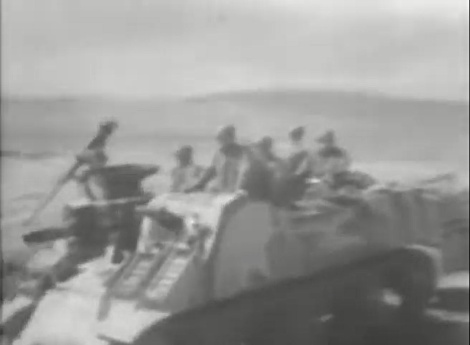
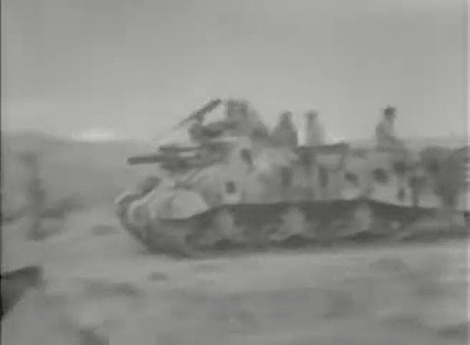
Documented use of the M7 during the Tunisian Campaign is very
sketchy. It is thought that most of the "105mm SPs" referenced in
various reports would have been T19s. The rest of the 1st Armored
Division shipped down from the U.K. and arrived in theater around
Christmas 1942. The 68th and 91st Armored Field Artillery Battalions,
along with the 2nd and 3rd Battalions of the 1st Armored Regiment
(Shermans), and the 3rd Battalion of the 13th Armored Regiment (Lees)
made their way to the front. The "new" units suffered devastating
losses, starting in late January 1942 and culminating with the Axis
attack in mid-February around Kasserine Pass. Many of the records of
these units were destroyed as they were overrun, so that there is only
an impressionistic view of what happened. The After Action Report of the
91st Armored Field Artillery Battalion is a case in point, "This
Battalion had previously taken part in a battle at Faid Pass, the
records of which were destroyed by enemy action, along with all data up
to and including February 15." On 19 February, the 91st AFA Bn. was
positioned about 20 miles southeast of the major Allied supply depot at
Tebessa. At full strength the 91st AFA would have had about 500 men.
They reported 107 officers and enlisted men were missing in action, but
gave no account of killed, wounded and vehicle casualties. A few days
later, the Axis advance was stopped at Djebel El Hamra and Thala.
Recognizing that the offensive could get no further, German-Italian
forces withdrew though Kasserine Pass. On 27 February, the 91st AFA Bn.
received 61 replacements and specifically reported that they "drew
M7's." As was the case with the Armored Regiments, the men and machines
were likely supplied from units stationed in Morocco. From then until
the Axis surrender on 13 May 1943, it would appear that some M7s served
in the 1st AD's Armored Field Artillery Battalions. For instance, on 20
March 91st AFA Bn reported that an M7 was damaged by a strafing attack
near Station Sened. In mid-April, "M7s assembled in vicinity Sbietla to
be loaded on transporters for movement." The Battalion performed many
fire missions, but nowhere do the AARs give the combat efficiency
(numbers) or break down the types of the 91st's 105 SPs. Here we have
some poor-quality screen captures of some raw Signal Corps footage
showing a pair of camouflaged M7s with trailers captioned as "after the
battle of Kasserine Pass, 1943."
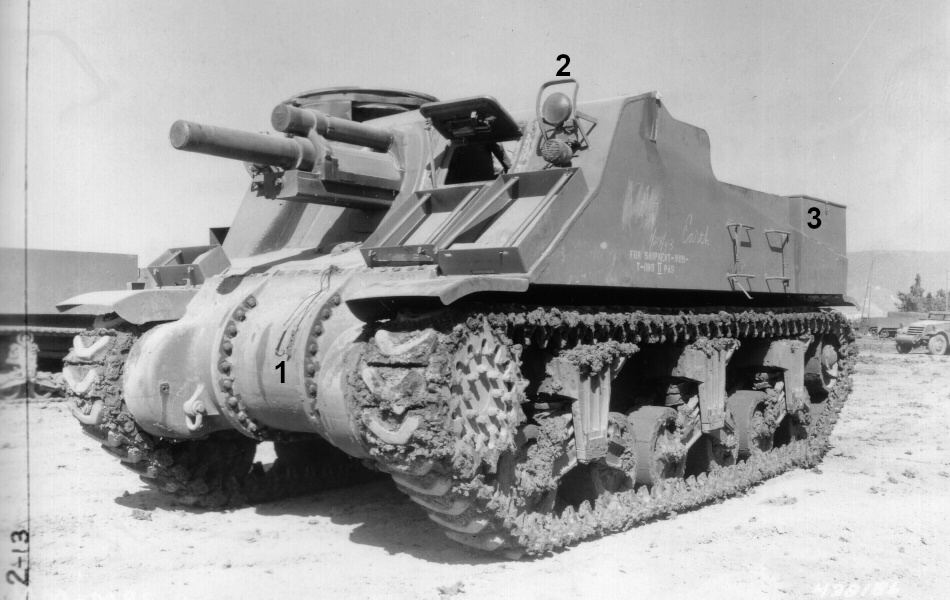
This Signal Corps photo is dated 5 April 1943 and captioned "Oran, North
Africa...Left front view of a 105MM howitzer motor carriage M7, taken
at the MBS Ordnance." According to the US Army "Green Book," "The
Ordnance Department: On Beachhead and Battlefront," the Mediterranean
Base Section at Oran was established in early December 1942. "The first
echelon of the Atlantic Base Section at Casablanca was just arriving [in
late December]. Eventually there was to be an Eastern Base Section
(EBS) at Constantine [Algeria], nearer the front, but it did not come
into being until late February 1943." Thus, the supply line to the front
in Tunisia "was very long and very weak." By the time our photo was
taken in April 1943, the Base Sections were handling enormous amounts of
equipment and supplies not just for the front in Tunisia, but for the
purpose of equipping the Allied Armies including the French, slated to
take part in future operations in Sicily, Italy and beyond. This M7 can
be seen with the stencil "For Shipment -9999-" and the date "1/24/43"
chalked on just above. We doubt if it had been sitting at Oran for over 2
months, so assume that the January date was chalked on in the US. The
"comb device" (1) was typical of the Chester Tank Depot in Pennsylvania
where this M7 would have been processed for overseas shipment. The
sealing has not yet been removed from the area around the gun. Counting
heads suggests that the head light guards (2) were introduced in
production in August 1942 and the top hinged, M3 Lee type stowage bin
(3) in September.
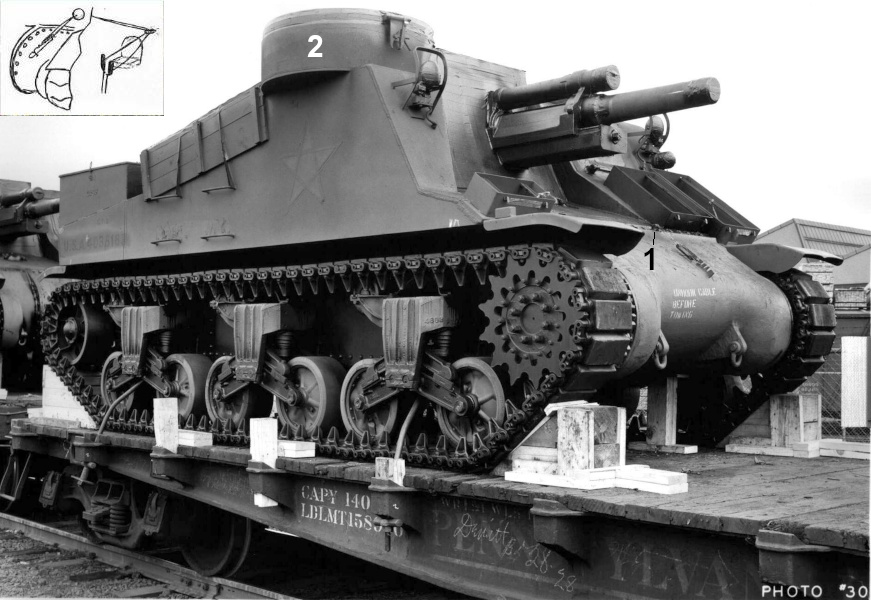 Here we have a view of an M7 processed, sealed and ready to go at the
Chester Tank Depot. No date is provided but the Registration Number can
be seen as "USA 4038163" indicating November 1942 acceptance. Note how
the fighting compartment is covered with a wood frame which is held down
by straps attached to the step rungs. The suspension components have
been sprayed with a rust preventative compound known as Par-Al-Ketone.
Right under the CTD "comb device" are the instructions "Unhook Cable
Before Towing." The "comb" or "pawl" was part of a system engineered as a
way to lock or unlock the brakes during shipping without damaging the
vehicle's waterproofing sealant. Note the roller (1) attached to the
middle of the differential housing bolt strip. It is thought that
5/32-inch cables were threaded through the roller and into the fighting
compartment by means of a hole made when the middle bolt was removed
from the center section of the bolt strip. The drawing in the inset was
provided by the Chief Ordnance Officer of the Longue Point Ordnance
Depot [Montreal] and shows how the cables were attached to the steering
levers in order to lock the vehicle down during shipping. For the
purpose of "counting heads" we would note that this November 1942 M7
"still" has the original "shallow" pulpit (2).
Here we have a view of an M7 processed, sealed and ready to go at the
Chester Tank Depot. No date is provided but the Registration Number can
be seen as "USA 4038163" indicating November 1942 acceptance. Note how
the fighting compartment is covered with a wood frame which is held down
by straps attached to the step rungs. The suspension components have
been sprayed with a rust preventative compound known as Par-Al-Ketone.
Right under the CTD "comb device" are the instructions "Unhook Cable
Before Towing." The "comb" or "pawl" was part of a system engineered as a
way to lock or unlock the brakes during shipping without damaging the
vehicle's waterproofing sealant. Note the roller (1) attached to the
middle of the differential housing bolt strip. It is thought that
5/32-inch cables were threaded through the roller and into the fighting
compartment by means of a hole made when the middle bolt was removed
from the center section of the bolt strip. The drawing in the inset was
provided by the Chief Ordnance Officer of the Longue Point Ordnance
Depot [Montreal] and shows how the cables were attached to the steering
levers in order to lock the vehicle down during shipping. For the
purpose of "counting heads" we would note that this November 1942 M7
"still" has the original "shallow" pulpit (2).
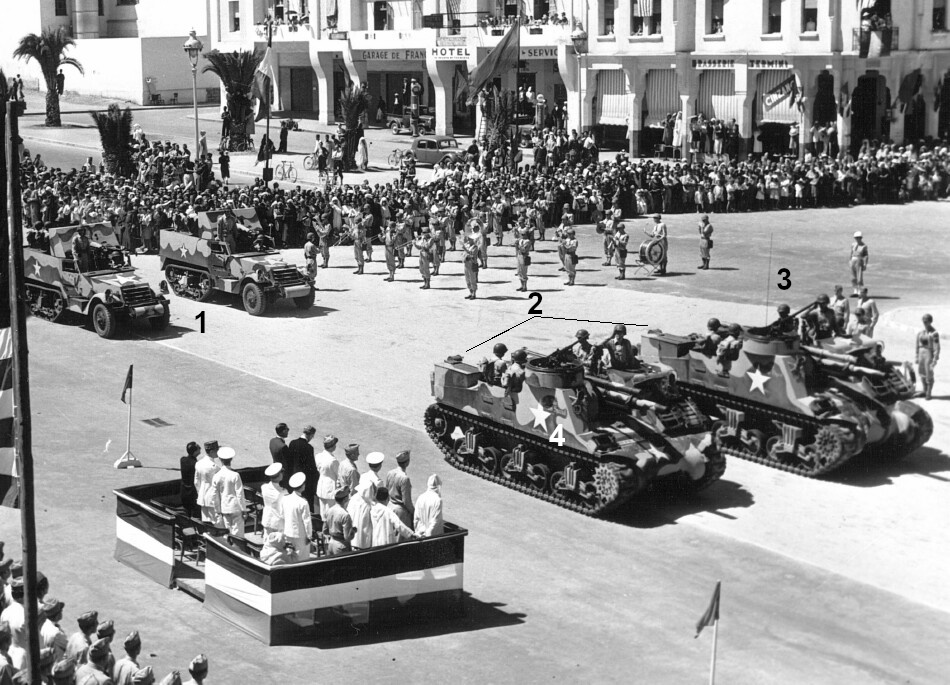
Aside from the Armored Field Artillery Battalions of the 1st and 2nd
Armored Divisions, the 5th Armored Field Artillery Group was organized
in Morocco on 25 January 1943. The Group which would serve as a US II
Corps asset, consisted of the 58th, 62nd and 65th Armored Field
Artillery Battalions. "The battalions...received their training on towed
75’s and 105’s and on the half-tracked T.19. The full-tracked M7 was a
new piece of equipment." The 58th AFA Bn is reported to have received 18
"brand new" M7s while stationed at Camp A.P. Hill, Virginia in
September and October 1942, but it is not reported if they brought them
along when they deployed to northwest Africa. The Battalions of the 5th
Artillery Group had their combat debuts in late March 1943 in the area
of Maknassy in support of the 1st Infantry Division and the 1st Armored
Division. We can't confirm if the battalions were entirely equipped with
M7s at the time, but the 58th AFA Bn reported the loss of 2 M7s to
counterbattery fire on 25 March. Additionally, a member of the 65th AFA
Bn stated that the M7 proved "itself an excellent weapon for...the
roving gun technique." In any case, it can be documented that the
battalions of the 5th AFA Group had "some" M7s as they supported various
US units to the end of the campaign in Tunisia. In August 1942, each
infantry regiment was ordered to be provided with a battery of organic
artillery known as a "Cannon Company." The company's mission was "to
provide close and continuous fire support to the regiment." During the
Tunisian Campaign, some companies appear to have been composed of 2 T19s
or 2 M7s (as they became available) and 4 half-track based T30 75mm
Howitzer Motor Carriages. Starting in July 1943, the organization was
changed and "The Cannon Company was equipped with a total of 6 M3 105mm
towed howitzers with 118 men total strength." However, period photos
and unit reports show that some M7s continued to serve in Cannon
Companies during the Italian Campaign. It is thought that the parade
scene above was filmed on Bastille Day, 14 July 1943 in Rabat, Morocco,
and shows 2 of the platoons of a Regimental Cannon Company with the T30s
(1) trailing. The M7s can be seen with a cable reel (2) for telephone
communications. The unit in the background has what appears to be an
antenna (3) suggesting it is equipped with a radio. The Priests have
headlight guards and the later stowage bins. Note that each M7 has an
engine crank on the lid of the right-side bin. Illustrating the
seemingly random nature of the components, the unit in the foreground is
equipped with a one-piece differential along with "M3" bogies with
welded, spoked road wheels, while the other has a three-piece diff and
"M4" bogies with pressed metal road wheels. The Priest in the foreground
carries the name "The Texas Special" (4).
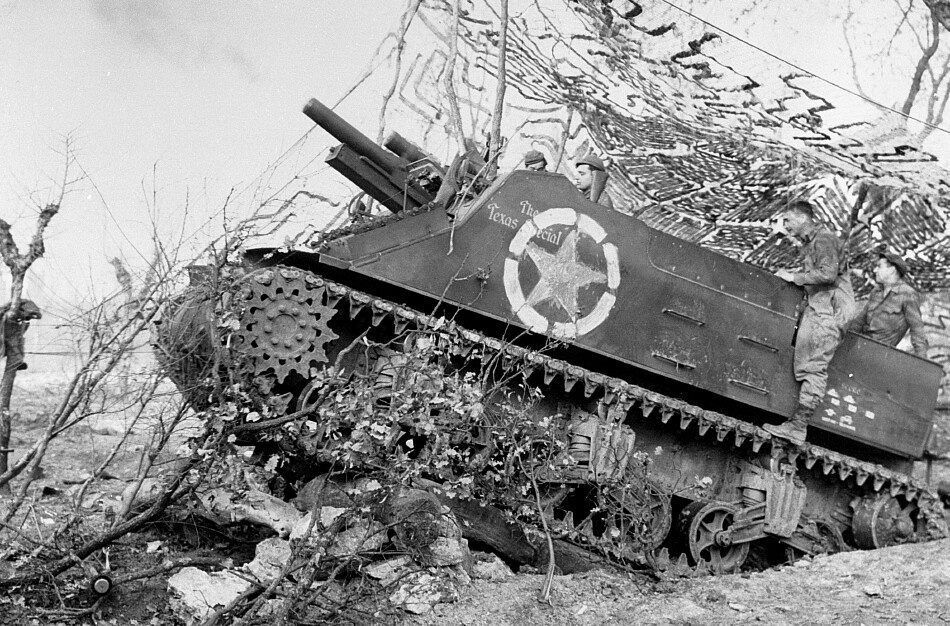
Skipping ahead 6 months, here we see "The Texas Special" in action in
the "Rapido River area, Italy" on 22 January 1944. The camouflage scheme
seen in the Rabat photo has toned down quite a bit. The star can be
seen to have been surrounded in this instance by a crudely painted
circle. Some elements fighting in Tunisia thought that the star by
itself had on occasion been mistaken for the German cross and had led to
friendly fire incidents. Consequently, a circle was ordered to be
painted around the star beginning with the Sicilian campaign. In any
case, the crew has attempted to make the star a little less conspicuous
with fingerpainted mud. A strip of armor plate has been neatly welded to
the side as suggested by earlier M7 users both British and US. The
veteran crew have painted on a scoreboard that appears to show 2 tanks, 3
trucks, a "Scout Car" and a "Volkswagen". A knock against the Priest
during WW II and the Korea War was its limited elevation. Here the crew
has placed it on a ramp to increase its angle of fire. The Signal Corps
photo caption identifies "The Texas Special" as with "Third Platoon,
Cannon Company of the 143rd Infantry Regiment." The 36th Infantry
Division arrived in Oran in April 1943. It was composed of the 141st,
142nd and 143rd Infantry Regiments, each of which would have included a
Cannon Company. According to "A Pictorial History of the 36th "Texas"
Infantry Division", the 141st and 143rd Regiments spent "a leisurely
summer in the cork forests near Rabat and Casablanca." The Division had
its baptism of fire when it made an assault landing at Salerno Bay in
Italy on 9 September 1943. The After Action Report for that day mentions
that one of the "75mm Self-Propelled mounts" of the Cannon Company,
143rd IR, played a part in repelling a tank attack against the Division
Command Post. The photo above is dated 22 January 1944. In the previous
48 hours, the 141st and 143rd Infantry Regiments had sustained 1,681
casualties, including 143 killed, 663 wounded, and 875 missing in a
disastrous series of attacks across the Rapido River that became the
subject of a Congressional investigation in 1946.
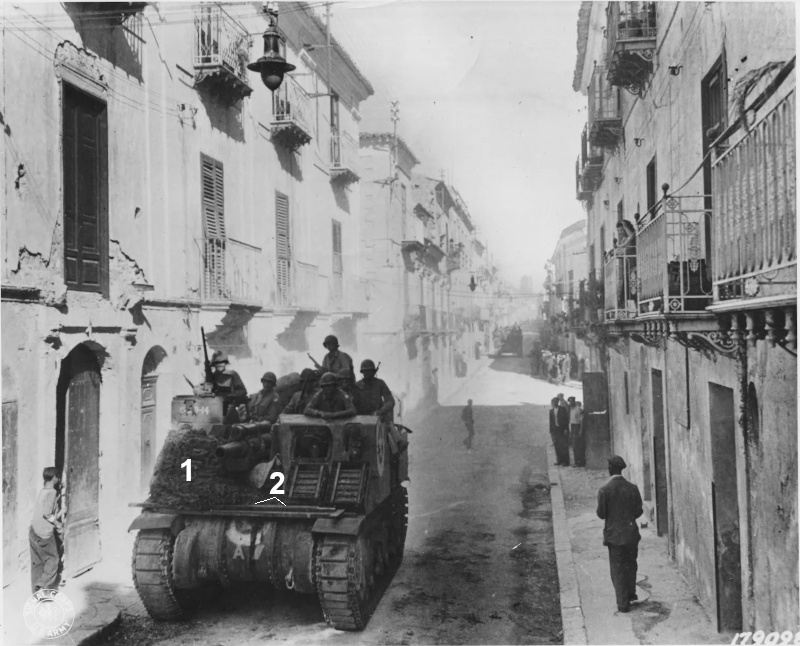 Returning to the historical chronology, although the Allied
victory in Tunisia in May 1943 came months later than had been hoped, it
was quite impressive, nonetheless. Hitler's "no retreat" obsession,
coupled with the growing strength of Allied Naval and Air power in the
Mediterranean set the stage for one of those rare occasions in warfare
where the entire enemy force was destroyed. A quarter of a million Axis
troops were captured, which rivaled in scope the Soviet victory at
Stalingrad a few months earlier. The "higher ups" had decided that the
next objective would be Sicily. The newly created US Seventh Army
invaded the island alongside the veteran British Eighth Army on 10 July
1943. The Seventh Army Order of Battle included the 3 Armored Field
Artillery Battalions (58th, 62nd and 65th) of the 5th Armored Field
Artillery Group along with the 14th, 78th and 92nd AFA Battalions of the
2nd Armored Division. It is thought that, at this point, the majority
of the self-propelled howitzers in these units would have been M7s.
Perhaps the first US Army Priests to come ashore on D-Day were those of
the 10th Field Artillery Battalion, 3rd Infantry Division. As part of
"Joss Force" the western most Task Force in the US assault, they landed
at 0630, 10 July on Red Beach near Licata, "Unloading quickly, utilizing
the full-tracked mobility of its M 7's, the artillery unit established
firing positions 500 to 1,000 yards inland and began firing in support
of the infantry units." The 3rd ID's Field Artillery Battalions (9th,
10th and 39th) would have been equipped with towed howitzers, but a
footnote in the US Army "Green Book", "Sicily and the Surrender of
Italy" explains an unusual trade, "Before embarking them in North
Africa, General Truscott had his organic artillery battalions exchange
their towed 105-mm. howitzers for the full-tracked M7s of the 5th
Armored Field Artillery Group, a swap to last during the assault phase
only. Once ashore, the units exchanged pieces again." We can only assume
that General Lucian Truscott, commander of Joss Force, thought that
self-propelled guns would offer an advantage during the assault
landings. We don't know of any photos of the M7s of the 10th FA
Battalion on the first day, so offer the above Signal Corps photo dated
11 July 1943 and simply captioned, "U.S. armored troops moving through
Palma, Sicily." This scene likely shows elements of Combat Command A,
2nd Armored Division as they made their way through Palma di Montechiaro
to Naro, 10 miles to the north. Aside from the 3rd Infantry Division,
Truscott's Joss Force included CCA which, on that day, "consisted of the
66th Armored Regiment; the 41st Armored Infantry Regiment, minus the
1st Battalion; the 14th Armored Field Artillery Battalion; the 62d
Armored Field Artillery Battalion (which, at this time, had only one
battery ashore); reconnaissance, engineer, and service units." The
tactical (?) markings on the pulpit are partially obscured, except for
"-14." We might assume that the M7s shown above were serving with either
the 2nd AD's 14th AFA Bn. or the 5th Armored Field Artillery Group's
62nd AFA Bn. which was then attached to CCA. While not the best photo,
it can be seen that a camouflage net (1), possibly the "Net, camouflage,
cotton shrimp, 45-ft X 45-ft" supplied with the M7, is stowed on the
right front. The poles (2) running across the front are probably the
supports for the net. Note that this unit does not appear to be towing
an ammunition trailer.
Returning to the historical chronology, although the Allied
victory in Tunisia in May 1943 came months later than had been hoped, it
was quite impressive, nonetheless. Hitler's "no retreat" obsession,
coupled with the growing strength of Allied Naval and Air power in the
Mediterranean set the stage for one of those rare occasions in warfare
where the entire enemy force was destroyed. A quarter of a million Axis
troops were captured, which rivaled in scope the Soviet victory at
Stalingrad a few months earlier. The "higher ups" had decided that the
next objective would be Sicily. The newly created US Seventh Army
invaded the island alongside the veteran British Eighth Army on 10 July
1943. The Seventh Army Order of Battle included the 3 Armored Field
Artillery Battalions (58th, 62nd and 65th) of the 5th Armored Field
Artillery Group along with the 14th, 78th and 92nd AFA Battalions of the
2nd Armored Division. It is thought that, at this point, the majority
of the self-propelled howitzers in these units would have been M7s.
Perhaps the first US Army Priests to come ashore on D-Day were those of
the 10th Field Artillery Battalion, 3rd Infantry Division. As part of
"Joss Force" the western most Task Force in the US assault, they landed
at 0630, 10 July on Red Beach near Licata, "Unloading quickly, utilizing
the full-tracked mobility of its M 7's, the artillery unit established
firing positions 500 to 1,000 yards inland and began firing in support
of the infantry units." The 3rd ID's Field Artillery Battalions (9th,
10th and 39th) would have been equipped with towed howitzers, but a
footnote in the US Army "Green Book", "Sicily and the Surrender of
Italy" explains an unusual trade, "Before embarking them in North
Africa, General Truscott had his organic artillery battalions exchange
their towed 105-mm. howitzers for the full-tracked M7s of the 5th
Armored Field Artillery Group, a swap to last during the assault phase
only. Once ashore, the units exchanged pieces again." We can only assume
that General Lucian Truscott, commander of Joss Force, thought that
self-propelled guns would offer an advantage during the assault
landings. We don't know of any photos of the M7s of the 10th FA
Battalion on the first day, so offer the above Signal Corps photo dated
11 July 1943 and simply captioned, "U.S. armored troops moving through
Palma, Sicily." This scene likely shows elements of Combat Command A,
2nd Armored Division as they made their way through Palma di Montechiaro
to Naro, 10 miles to the north. Aside from the 3rd Infantry Division,
Truscott's Joss Force included CCA which, on that day, "consisted of the
66th Armored Regiment; the 41st Armored Infantry Regiment, minus the
1st Battalion; the 14th Armored Field Artillery Battalion; the 62d
Armored Field Artillery Battalion (which, at this time, had only one
battery ashore); reconnaissance, engineer, and service units." The
tactical (?) markings on the pulpit are partially obscured, except for
"-14." We might assume that the M7s shown above were serving with either
the 2nd AD's 14th AFA Bn. or the 5th Armored Field Artillery Group's
62nd AFA Bn. which was then attached to CCA. While not the best photo,
it can be seen that a camouflage net (1), possibly the "Net, camouflage,
cotton shrimp, 45-ft X 45-ft" supplied with the M7, is stowed on the
right front. The poles (2) running across the front are probably the
supports for the net. Note that this unit does not appear to be towing
an ammunition trailer.
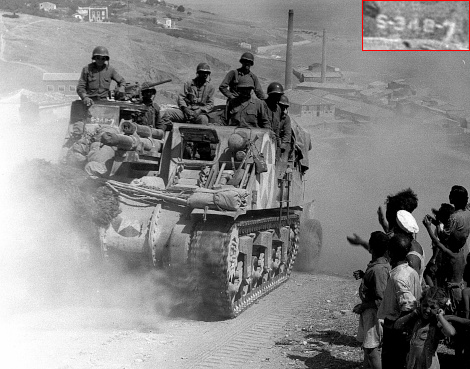

After the beachheads were secure, the US Seventh Army was tasked with
"the passive mission" of guarding the British Eighth Army's rear as it
fought its way up eastern Sicily with the port of Messina as its goal.
General George Patton managed to convince the rather reluctant Fifteenth
Army Commander, General Harold Alexander, that the best way to do that
was to secure all of western Sicily. To that end, on 15 July, Patton
formed a Provisional Corps made up of the 3rd Infantry Division, the
82nd Airborne Division and elements of the 9th Infantry Division. The
2nd Armored Division was held in army reserve, "prepared to exploit any
offensive operation toward the north coast." Starting on 19 July, the
Provisional Corps conducted a "power drive" across the island and
captured the Sicilian capital of Palermo on 22 July 1943. A series of
photos and some raw movie footage was shot showing a pair of M7s
proceeding up a hill on Highway 115 near the town of Sciacca on the
southwest coast. The Task Force of the 82nd Airborne entered Sciacca on
20 July. Some markings can be seen on the pulpit of the Priest in the
left photo. We read these as "something like" "S-348-7" (inset). We
haven't been able to interpret this, so it may be "encrypted" tactical
marking code. In any case, according to an 82nd AB history, "Batteries
of the 376th [Parachute Field Artillery Bn.] 34th [Field Artillery Bn.,
9th Infantry Div.] and 62d [Armored] Field Artillery had been called
into action briefly on enemy batteries, pillboxes, and personnel east of
Sciacca." Our guess is that the Priests were of the 62nd AFA Bn. of the
5th Armored Field Artillery Group. Again, we see the camouflage net and
poles. Both M7s have head light guards and the unit in the right-side
photo can be seen with a side hinged stowage bin. Both are towing
ammunition trailers. The vertically stowed 105mm rounds are just visible
on both M7s indicating that neither was retrofitted with additional
armor plate protection.
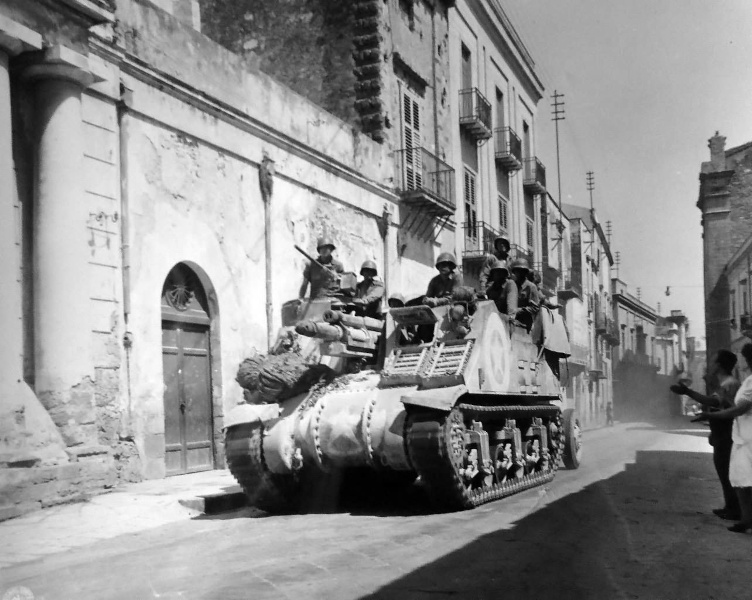
The Signal Corps film footage shows at least 3 M7s proceeding past the columned edifice of the Palazzo
Arone di Bertolino, located at 160 Corso Vittorio Emanuele in Sciacca
(per Google Steet View). The Priest shown above and at least one of the
others in the scene are noted to have been retrofitted with additional
armor plates welded on to protect the vertically stowed 105mm rounds.
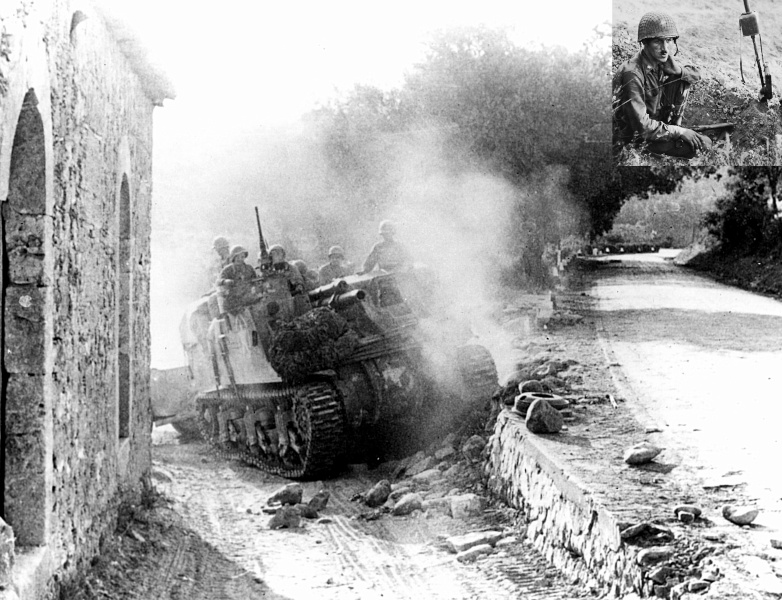
By the end of the Sicilian Campaign, the M7 had proven itself to be a
valuable weapon in the Allied arsenal. At that point, ALCO had produced
about 2800 units, and more were on order. Two 4-gun batteries of the
58th AFA Bn., 5th Armored Field Artillery Group took part in a pair of
unusual missions involving "end run" amphibious landings on the
northeast coast of Sicily. The "invasion force" was made up of about 650
men led by Lt. Col. Lyle Bernard commander of the 2nd Battalion, 30th
Infantry Regiment, 3rd Infantry Division. Barnard's battalion was
supported by 5 Shermans of the 756th Tank Battalion, elements of the
10th Engineer Combat Bn. and the 540th Amphibious Engineer Regiment with
DUKWs, plus Batteries A and B of the 58th AFA Bn. While the first
landing which came ashore near Sant'Agata on 8 August 1943 caught the
enemy off guard, most of the Axis troops managed to retreat past the 2nd
Battalion's blocking positions before the 3rd ID's main force linked up
with them. However, "the 3d Infantry Division's combined land and sea
offensive bagged over 1,000 prisoners." The next end run, which became
known as the battle at Brolo, took place 11-12 August 1943 and used the
same small but proven task force as the first. This time the Germans
recognized the real possibility that their retreat route might be cut
off and attacked the 2nd Battalion with all of the tanks, infantry and
artillery that they could muster. After a day long fight, the Germans
managed to escape the trap, but it was a near run thing. The 1st
Battalion coming overland linked up with the 2nd on the morning of 12
August. The action cost the 2nd Battalion 177 men killed, wounded and
missing. Batteries A and B of the 58th AFA Bn. had 9 men killed, 25
wounded and 14 missing. In addition, 7 of the unit's M7s were destroyed,
including 4 by friendly air attack. It is thought that the photo above
shows a 58th AFA Bn. M7 in action during the first landing. Note that
the M7 has been retrofitted with steel T49 "cast track with interrupted
parallel tread." There is some mention in the files that rubber tracks
wore out quickly on Sicily and steel tracks were preferred. The inset
shows Col. Bernard during the battle. The Sicilian Campaign ended a few
days later on 17 August, but there was no repeat of the mass surrender
of "Tunisgrad". For reasons that are still debated, the significant
Allied naval and air forces in the area failed to block the Strait of
Messina permitting 40,000 German and 70,000 Italian troops to escape
into Italy. After Sicily, the 5th Armored Field Artillery Group
redeployed to Great Britain along with the 1st Infantry and the 2nd
Armored Divisions in anticipation of the Normandy Invasion.
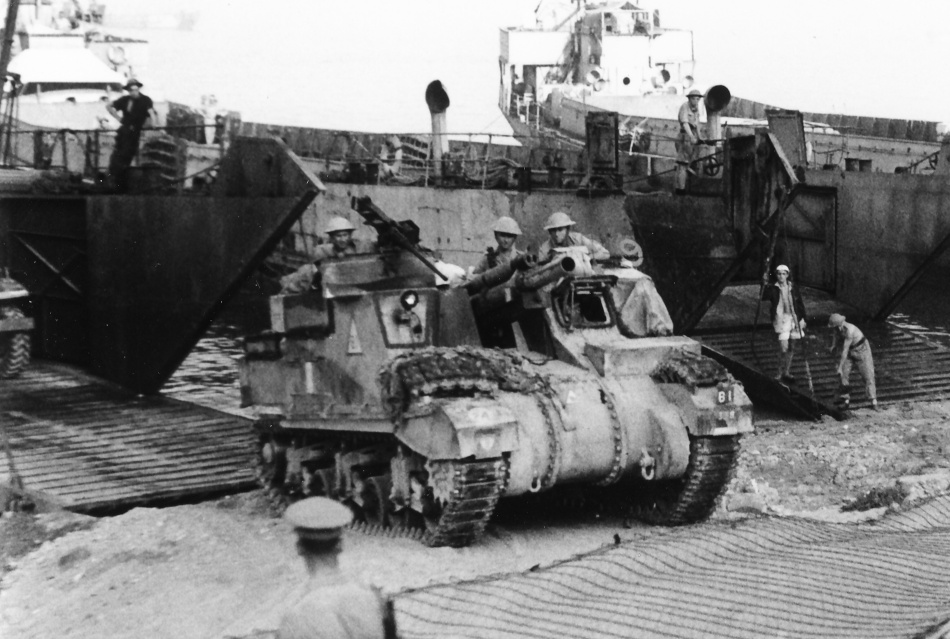
The British Eighth Army landed the first Allied troops back on the
continent of Europe (to stay) on 3 September 1943 as part of Operation
Baytown. The caption of the IWM photo above simply reads, "(Armoured
cars, tanks and artillery coming ashore nr. Reggio.)
Taken by Sgt. Loughlin 3.9.43 [3 September 1943]". The Unit Serial
Number of the Priest appears to be "338" which would indicate the 98th
(Sussex and Surrey Yeomanry, Queen Mary's) Field Regiment, Royal
Artillery, a veteran unit first equipped with M7s for
the Sicilian Campaign, directly under 8th Army control. The [British]
5th Division and the 3rd Canadian Brigade made the initial assault
across the Strait of Messina to the Calabrian Peninsula (the "toe" of
Italy) landing near the town of Reggio. The assault
was unopposed and by the end of the day, a perimeter 5 miles deep had
been established with the port of Reggio along with the airfield
captured largely intact. The Priest can be seen with a side hinged
stowage bin and without headlight guards. It was likely
one of the "emergency shipment" M7s modified in British workshops in
Egypt. It had also been retrofitted with the ammunition protector side
plates as seen in the photo of the Priest advancing "to contact the
enemy nr. NOTO [Sicily]" shown earlier. The tracks
look to be well worn. IWM NA 6205.
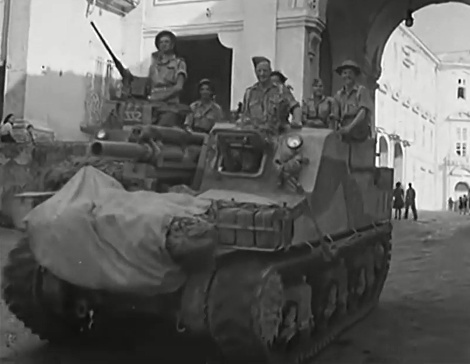
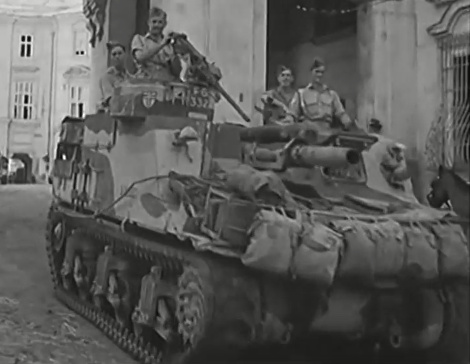 Readers
will recall the photos of a pair of M7s landing at Arzew on 9 November
1942. We speculated that these were serving with the 27th Armored Field
Artillery Battalion since it is listed as a component of CCB, 1st
Armored Division which landed as part of the Center Task Force of
Operation Torch. The 27th AFA Bn. was one of the first units of the 1st
AD to get a combat assignment after the drubbing the Division had taken
during the Tunisia Campaign. The battalion was attached to the US Fifth
Army invasion force that made assault landings near the port of Salerno
on 9 September 1943. According to a unit history, "The 27th first went
into action on the night of September 11, a few hours after their
105-millimeter howitzers were unloaded. "B" and "C" Batteries went into
direct fire positions covering a vital stream crossing and the following
day pulled back to join the third battery in indirect fire positions
supporting the 45th Infantry Division. The battalion's guns helped repel
the strongest German counterattack of the beachhead on the fourth night
after the landing." We haven't come across any photos or films, but in
this action on 13 July, there is a specific mention of 27th AFA M7s
firing in support of the 189th and 158th Field Artillery Battalions as
they were attacked by elements of the German XIV Panzer Corps, "seven
M-7's of Battery B, 27th Armored Field Artillery, came up in time to add
another 300 rounds. This devastating fire pulverized the roads and
fields in the tip of the [Sele-Calore] corridor and combined with the
dogged resistance of the artillerymen at the ford, hurled back every
enemy attack. At sunset, the enemy admitted failure and pulled back his
tanks. The artillery had stopped the most serious break-through
attempted during the whole Salerno beachhead fight." The German plan to
crush the Fifth Army at Salerno was nearly successful; however, in the
end, they could not overcome the combined weight of Allied infantry,
artillery, naval and air power, and were forced to withdraw to the
Volturno River. The major port of Naples was the ultimate goal of the
Salerno campaign and it was entered by units of the British 7th Armoured
Division on 1 October 1943. Here we have some screen captures showing a
pair of early production Priests, again likely from the "emergency
shipment", on the Reggia e Piazza San Ciro. The Unit Serial Number
painted on the pulpits appears to be "332" which would indicate the 24th
Field Regiment, Royal Artillery. Both are seen with the ammunition
protector side plates retrofitted, although the plate of the M7 on the
left appears to be welded on flush with the armor, while the one on the
right looks to be hinged and mounted proud of the side armor.
Readers
will recall the photos of a pair of M7s landing at Arzew on 9 November
1942. We speculated that these were serving with the 27th Armored Field
Artillery Battalion since it is listed as a component of CCB, 1st
Armored Division which landed as part of the Center Task Force of
Operation Torch. The 27th AFA Bn. was one of the first units of the 1st
AD to get a combat assignment after the drubbing the Division had taken
during the Tunisia Campaign. The battalion was attached to the US Fifth
Army invasion force that made assault landings near the port of Salerno
on 9 September 1943. According to a unit history, "The 27th first went
into action on the night of September 11, a few hours after their
105-millimeter howitzers were unloaded. "B" and "C" Batteries went into
direct fire positions covering a vital stream crossing and the following
day pulled back to join the third battery in indirect fire positions
supporting the 45th Infantry Division. The battalion's guns helped repel
the strongest German counterattack of the beachhead on the fourth night
after the landing." We haven't come across any photos or films, but in
this action on 13 July, there is a specific mention of 27th AFA M7s
firing in support of the 189th and 158th Field Artillery Battalions as
they were attacked by elements of the German XIV Panzer Corps, "seven
M-7's of Battery B, 27th Armored Field Artillery, came up in time to add
another 300 rounds. This devastating fire pulverized the roads and
fields in the tip of the [Sele-Calore] corridor and combined with the
dogged resistance of the artillerymen at the ford, hurled back every
enemy attack. At sunset, the enemy admitted failure and pulled back his
tanks. The artillery had stopped the most serious break-through
attempted during the whole Salerno beachhead fight." The German plan to
crush the Fifth Army at Salerno was nearly successful; however, in the
end, they could not overcome the combined weight of Allied infantry,
artillery, naval and air power, and were forced to withdraw to the
Volturno River. The major port of Naples was the ultimate goal of the
Salerno campaign and it was entered by units of the British 7th Armoured
Division on 1 October 1943. Here we have some screen captures showing a
pair of early production Priests, again likely from the "emergency
shipment", on the Reggia e Piazza San Ciro. The Unit Serial Number
painted on the pulpits appears to be "332" which would indicate the 24th
Field Regiment, Royal Artillery. Both are seen with the ammunition
protector side plates retrofitted, although the plate of the M7 on the
left appears to be welded on flush with the armor, while the one on the
right looks to be hinged and mounted proud of the side armor.
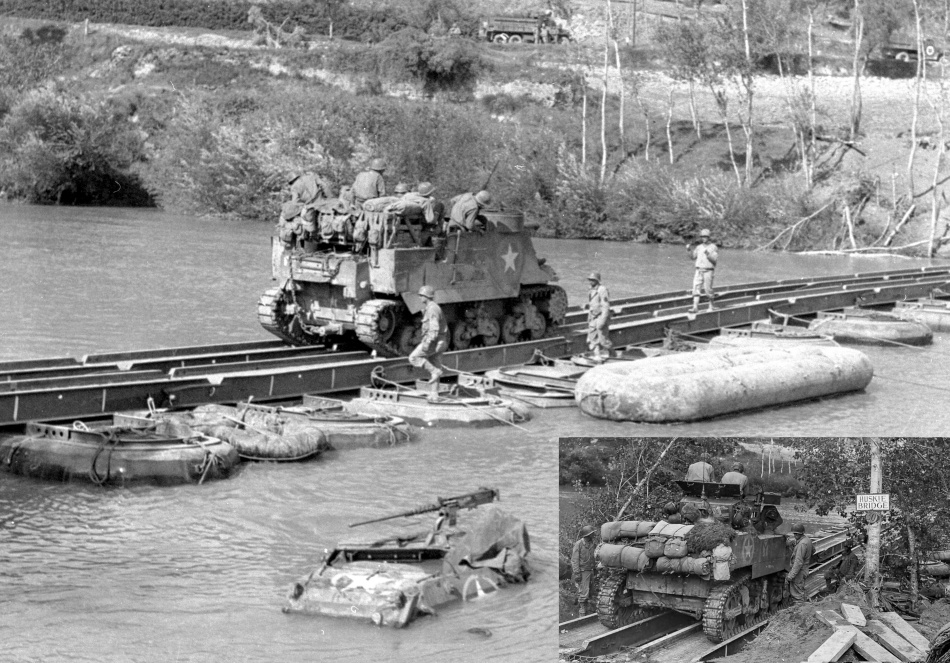
Through
a series of well planned and executed maneuvers, the 3rd Infantry
Division was able to jump the Volturno River before the German defenses
could be set, forcing them back 20 miles to their next position, the
"Barbara Line." The photo above is undated and captioned, "Tank
Destroyer [sic] moves on pontoon bridge across Volturno." We've examined
a number of photos and motion pictures and have been able to determine
that this is the "VI Corps Bridge" at the Triflisco Gap. This 30-ton
capacity treadway bridge was reportedly erected in 6 hours on 14 October
by Company B of the 16th Armored Engineer Battalion, another unit of
the 1st Armored Division that was returned to action earlier than the
rest of the Division. The well-known photo in the inset shows an M5A1
light tank with the distinctive unit marking (black "Y" in a yellow
square) of the 601st Tank Destroyer Battalion. The 601st TD Bn. was
attached to the 3rd ID at the time and for most of the war. Note that a
sign nailed to the tree labels it the "Huskie Bridge." In the main
photo, just the turret of a submerged M10 Tank Destroyer can be seen in
the river. The US Army Green Book "Salerno to Cassino" mentions that a
tank destroyer "fell off the bridge...drowning four men" on the night of
the 14th. Various motion pictures show
both US and British units pouring across the Huskie Bridge the next
day. The M7 can be seen as another early production model with side
hinged stowage bins. It even appears to have an unnotched upper rear
hull plate. (Either that or a notched plate was altered to accommodate a
wading kit.) Welded on side armor is evident. We are not able to
determine at present if the regimental cannon companies of the 3rd ID
were equipped with any M7s in mid-October 1943. If not, our best guess
is that the Priest on the bridge was with the 69th Armored Field
Artillery Battalion of the 6th Armored Field Artillery Group.
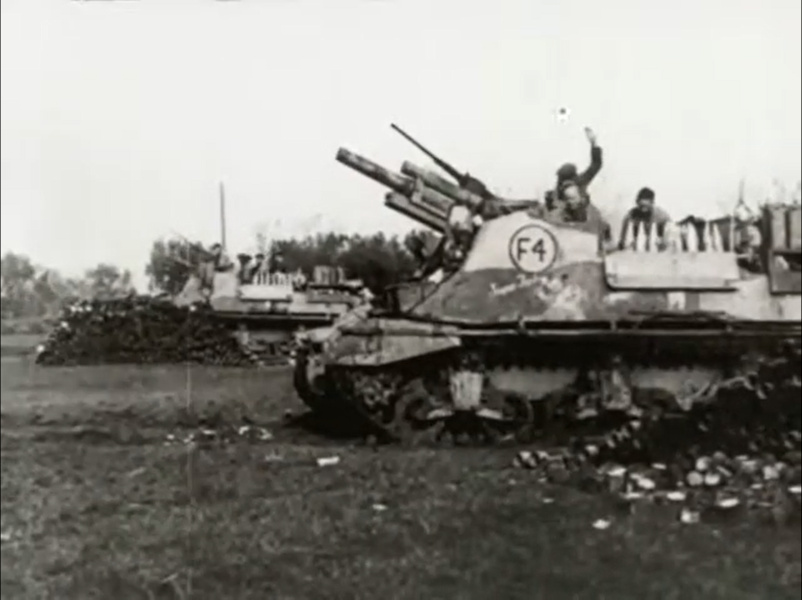
After the capture of Naples and the Foggia Airfield Complex, Allied
planners projected a phase line 30 miles north of Rome before the end of
1943, but any hopes for such progress were dashed as further advance
was halted in the Fall at the nearly impregnable position known as the
Gustav Line. On the Adriatic Coast, the Eighth Army hoped to take the
town of Ortona without a fight, but the Germans chose to mount a defense
and the bloody, close quarter combat in the rubble strewn streets took
on almost epic proportions and became known as the "Italian Stalingrad."
This screen capture from a Canadian Army Newsreel entitled "Battle of
Ortona" shows M7s executing a fire mission in support of elements
of the 1st Canadian Division and the 1st Canadian Armoured Brigade as
they attempted to break through the German defensive positions
protecting the town. Of course, no date is provided in the film's
narrative, but the official Canadian history describes an action on 15
December 1943, "Early in the afternoon enemy shelling slackened as a
force of 200 paratroopers with tank support launched a determined
counter-attack. The weakened battalion [the Royal 22e Régiment]
contracted to withstand the shock and to allow a margin of safety for
our artillery fire. Speedy and efficient action by the self-propelled
105-millimetre guns of the 98th Army Field Regiment R.A., which in
fifteen minutes hit the enemy with 1400 rounds, crippled the German
thrust, and sent the discomfited paratroopers reeling back with heavy
losses." On the 18th of December, the Canadians launched Operation
""Morning Glory"...designed to drive a deep salient into the German
defence line south-west of Ortona, from which an attack might be mounted
against the town itself." The attack was "supported by all the
artillery of the 5th Corps, consisting of three medium and nine field
regiments and a heavy anti-aircraft battery." In a list of the
supporting artillery units, only the 98th FA is labeled as "SP" [self
propelled]. As best we can tell, the 98th with the Eighth Army and the
24th Field Regiment with Fifth Army were the only British/Commonwealth
M7 equipped units in Italy in 1943. It is thought that the "F4" marking
would indicate the 4th Gun of F Troop in the 3rd Battery of the
Regiment. Again, we see the early production side opening storage bins.
In this case, the retrofitted side armor was obviously hinged and is
seen in the "down" position.
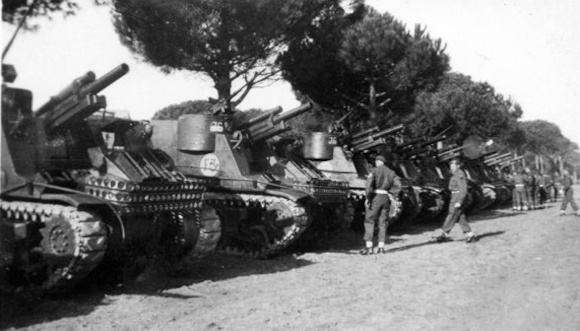
In late 1943, the strength of the 1st Canadian Infantry Division
and 1st Canadian Armoured Brigade fighting in Italy was augmented when
the 5th Canadian Armoured Division was shipped down from Great Britain.
The units formed the 1st Canadian Corps under the command of
Lieutenant-General Harry Crerar. As part of the move, the 8th Canadian
Field Regiment arrived in Naples on 1 December 1943. A few days later
they took over the 25 pounders, Quad Gun Tractors and "6 tanks" from the
3rd Royal Horse Artillery. Their War Diary mentions that the equipment
was "in poor shape and still has the sand of Africa in gas tanks, etc.
Fuel lines are continually clogging." The Regiment spent December
performing organization, maintenance and training tasks. They were
assigned to be part of the 5th Canadian Armoured Division and allotted a
new unit serial number - 76, which they painted on their vehicles and
equipment. As part of an armoured division, their guns were wanted to be
self-propelled, so in January 1944 the unit took over 25 M7s and other
vehicles and equipment from the British 98th Field Regiment (SP), the
unit shown in the photo of the previous caption. (Reading between the
lines, we believe that the 98th received new M7s at this time.) Again,
the 8th mentioned that the vehicles were in poor shape, and it is likely
that the Priests they received were from the original "emergency
shipment." The regiment, now the "8th Canadian Field Regiment (SP)",
conducted its first fire missions in February 1944 "on the Adriatic
front near Ortona." In April, in anticipation of the Allied Spring
Offensive, the Regiment "received 20 new Priests to replace the old
practically worn out SPs." The Regiment supported elements of the 5th
Cnd. Armoured Div. during the Fourth Battle of Cassino, "through the
Hitler Line and up the Liri Valley" and in a number of assaults on the
Gothic Line until 9 February 1945 when they were "ordered to turn in all
guns today...The majority of the SPs were received in April and May and
have given wonderful service in the Liri Valley and through the Gothic
Line. We are all very sorry to see our guns go and hope that the guns
received to replace them will be PRIESTS." The Regiment left Italy on 23
February and redeployed to Belgium and the Netherlands along with the
entire 1st Canadian Corps. This move was ordered so that the entire
Canadian Army Overseas would fight the rest of World War II together in
Northwest Europe under the banner of the First Canadian Army. By 8 March
1945, the Regiment had been issued 24 new Sextons which brought them up
to full strength. Their War Diary comments, "The new equipment is to be
a SEXTON, which is a 25 pr gun on a RAM chassis. It was hoped that the
regiment would be re-equipped with 105mm PRIESTS but they are not
available and ammunition for them is in short supply in the Canadian and
British Armies." Of course, at that point, the M7 was no longer
available because it had long since been replaced by the Sexton as the
Commonwealth's standard Self-Propelled Gun. The Regiment first went into
action with their new mounts in mid-April "on the southern outskirts of
Nijmegen." The uncaptioned photo above shows what we take to be a battery of 8
Commonwealth Priests in Italy. The Unit Serial Number "76" is visible
on two of the pulpits. We are told that this just signifies the second
senior regiment of any armoured division's artillery brigade (at this
time), but as mentioned, it was the USN assigned to the 8th Canadian
Field Regiment (SP) when they became part of the 5th Canadian Armoured
Division. The M7s appear to be lined up for some sort of review. The
8th's War Diary mentions that "R Battery went to Gen Collingwood's
inspection" on 31 July 1944. "Gen Collingwood" was the alias of King
George VI who had served on the HMS Collingwood during the Battle of
Jutland in 1916. The King was doing a weeks long tour of "his" forces in
Italy, but he is not in the photo, so we suspect it may have been taken
before or after his departure or on the previous day when "R Battery
practiced for Gen Collingwood's inspection (Exercise Trigger)." In the
arcane unit identification system used by Commonwealth gunners, "R
Battery" would have been the third battery of a Field Regiment, composed
of Troops E and F, and "F3" can be seen on the second M7 in. Note that
at least two of the Priests have so called "deep pulpits." "F3" can be
seen to have a field retrofitted side armor extension plate.
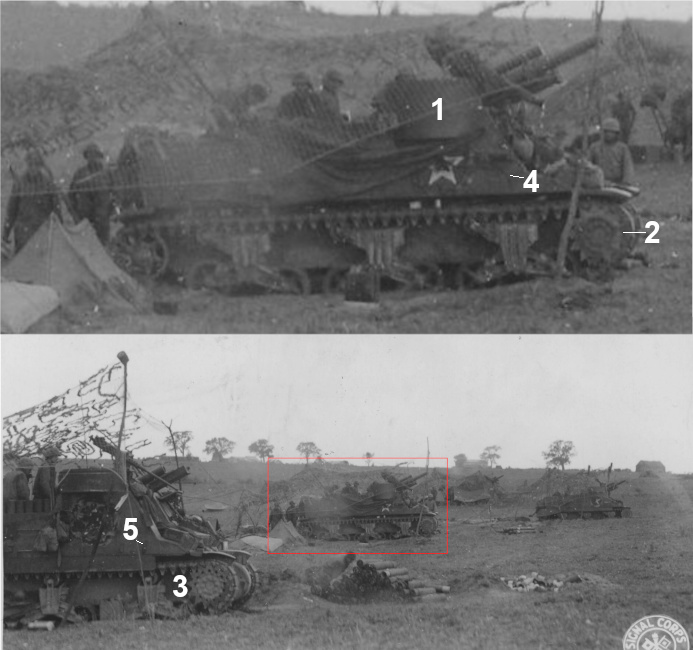
To break the stalemate at the Gustav Line and open the way to the
Italian capital of Rome, the Allies attempted a flanking maneuver with
an amphibious landing at Anzio in January 1944. However, the Germans managed to hold both the
Gustav Line and the Anzio perimeter until the Spring of 1944. The photo
above is dated 6 March 1944 and captioned, "M7, self propelled 105 mm
howitzers of the 191st Tank Bn., firing on enemy positions. 45th Div.
area, Anzio Beachhead." The "Table of Organization and Equipment 17-25",
dated 1 March 1942 authorized 54 generic "medium tanks" to a "Tank
Battalion (Medium)." (At the time, TBs were composed of light tanks only
or medium tanks only.) The Tank Battalion (M) Headquarters was
authorized 3 mediums and 17 were authorized for each of three tank
companies. The Battalion HQ was also authorized 3 generic
"self-propelled assault guns." Of course the mediums would have been
Lees and later, Shermans, but the identification of the 3
"self-propelled assault guns" is a bit sketchy, since according to the
June 1942 "Assault Gun Section and Platoon" Field Manual, "a standard
type has not yet been determined." Some sources have it that they were
halftrack based T30 75mm HMCs at first. It is thought that the 191st
"Tank Battalion (M)" was in the March 1942 configuration when they took
part in the assault landings at Salerno on 9 September 1943. The unit
records are vague as to type, but the Assault Gun Platoon did take part
in the assault landing, although it doesn't appear that the 191st had
any M7s at the time. In the records, Lt. Wesoloski is listed as
commander of the Assault Gun Platoon, and it is reported that his
"half-tracks experienced considerable difficulty in the marshy
terrain...just east of Yellow Beach." So we have the suggestion that the
Assault Guns were half-track based. In the same month of September
1943, TO&E 17-25 was changed. The most significant modification was
the addition of a fourth line company of 17 light tanks, to what had
been the "Tank Battalion (M)" but now simply became a "Tank Battalion."
The assault guns in the updated configuration are identified more
specifically as "medium tank with 105mm howitzer." The first 105mm
Shermans were not produced until February 1944 so this appears to have
been an anticipatory authorization. In the meantime, it appears that,
when the tank battalions in Italy reorganized to conform to the
September 1943 configuration, the M7 was substituted as the 105mm
"assault gun" but with only a 5 man crew authorized. Unit records
indicate that the 191st TB reorganized under the new TO&E when they
were in Corps Reserve at the end of 1943. The M7s were initially
allocated in accordance with the revised configuration with 3 in
Headquarters Company and 1 each in the 3 medium tank companies. However,
the lightly armored M7 was not really an "assault gun" and most Tank
Battalion commanders took it upon themselves to remove them from the
line companies and place them in the Headquarters Company so that they
had a fairly potent six gun artillery platoon. In the photo, four M7s
are visible, but we suspect that there are two more hidden in the
background. Of interest is that the Priest in the middle of the photo
can be seen with a "deep" pulpit (1), a feature that, by our reckoning,
was introduced in production at ALCO in January 1943. Around that time,
ALCO also transitioned to the use of the "plain" drive sprocket (2) on
both its M4 Shermans and M7 Priests. The "plain" can be compared with
the M3 Medium type sprocket (3) used by ALCO before that. The "deep"
pulpit M7 can just be seen with the support frames (4) for the canvas
cover installed, while the "shallow" pulpit unit on the left appears to
have the fittings (5) that held the support frames. At Anzio, the
Germans held the high ground and could zero in on any sector within the
perimeter. These Priests are under camouflage nets and an attempt had
been made to conceal the "Salerno" stars. Allied forces were contained
within the beachhead for 4 long and bitter months. The Germans bragged
that Anzio was "the largest self sustaining prison camp in Europe." In a
sense, the Italian Campaign imprisoned both sides as the overall
strategy devolved into a goal of tying down as many enemy forces as
possible so that they could not be used elsewhere. The Germans had a
tremendous defensive advantage due to the terrain and weather of Italy,
but for most of the campaign, about 400,000 Allied troops tied down
about 400,000 Germans and vice versa.
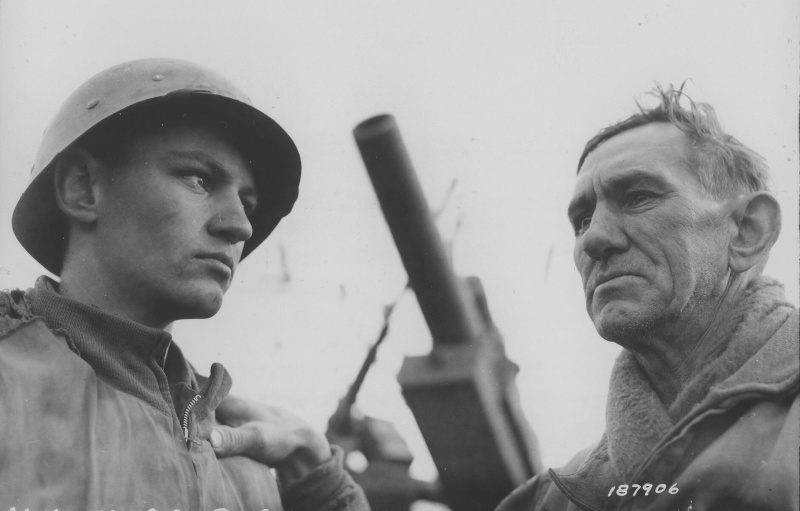
Part of the series of SC photos of the M7 "assault guns" of the 191st TB
features a touching story that we wanted to share. The caption to the
photo above: "6 March 1944. Father and Son Farewell. Pvt. William R.
Loop, Binghamton, N.Y., says goodbye to his Dad, Cpl. Roderick R. Loop,
Binghamton, N.Y., age 48, who is leaving Italy for a tour of duty in the
United States. Father and son are in the same outfit, a Tank Battalion
that figured prominently in knocking out several German Tanks in a
recent attack on the 45th Division, February 11, 1944. Father and son
enlisted together, took Basic Training at Fort Knox, Kentucky, together,
and came overseas together. Dad served in the First World War with the
124th Infantry [Regiment], 31st Div., the famous 'Dixie Division.'" Both
men survived and were reunited. William went on to serve with
distinction during the Korean War.
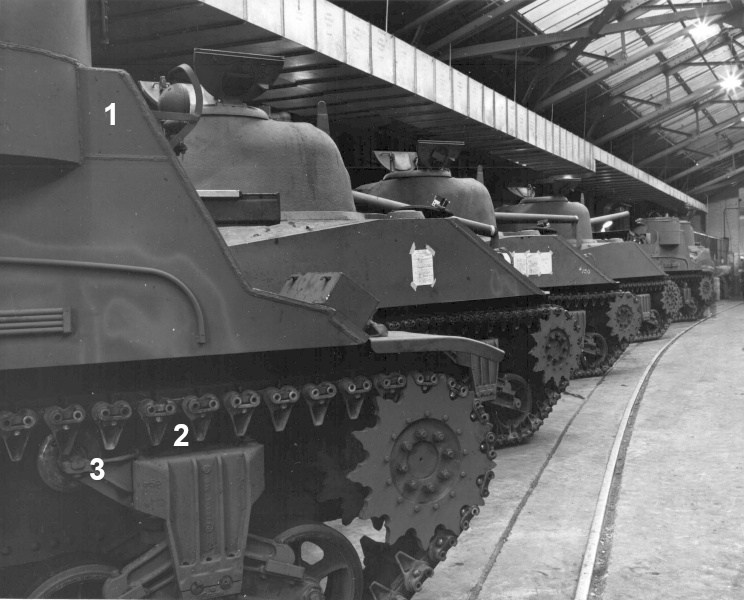 Returning to the ALCO plant in Schenectady, here we have a photo showing
a few Shermans and Priests nearing completion. The M7s do not yet have
their guns installed. Our scan of this Office of War Information photograph was
undated and uncaptioned, but based on a few similar, captioned ALCO
images, we suspect it was taken in January 1943 by photographer Howard R. Hollem. ALCO
manufactured 150 M4A2s from September 1942 through April 1943. The
company was ordered to switch Sherman production over to the M4 model
and began to manufacture those in February 1943. The
second Sherman in line can be seen with "150" chalked on, leading us to
speculate that this may have been their last M4A2 which would have been
accepted in April. (We wish it had been possible to read the sheets
taped to the sides of 2 of the Shermans.) In any case, both Priests are
seen with deep pulpits, plain sprockets and support frames installed.
From this we might infer that the canvas cover was introduced at about
the same time as the deep pulpit. M7s with deep pulpits are
characterized by an angled plate (1) welded into the top front, whereas
the side armor of shallow pulpit units is all one piece. The track skid
(2) of the M4 bogie can be seen to be in the second, asymmetrical
configuration, and the return roller (3) is in the original
configuration without the spacer modification that would raise the
rollers up by about an inch.
Returning to the ALCO plant in Schenectady, here we have a photo showing
a few Shermans and Priests nearing completion. The M7s do not yet have
their guns installed. Our scan of this Office of War Information photograph was
undated and uncaptioned, but based on a few similar, captioned ALCO
images, we suspect it was taken in January 1943 by photographer Howard R. Hollem. ALCO
manufactured 150 M4A2s from September 1942 through April 1943. The
company was ordered to switch Sherman production over to the M4 model
and began to manufacture those in February 1943. The
second Sherman in line can be seen with "150" chalked on, leading us to
speculate that this may have been their last M4A2 which would have been
accepted in April. (We wish it had been possible to read the sheets
taped to the sides of 2 of the Shermans.) In any case, both Priests are
seen with deep pulpits, plain sprockets and support frames installed.
From this we might infer that the canvas cover was introduced at about
the same time as the deep pulpit. M7s with deep pulpits are
characterized by an angled plate (1) welded into the top front, whereas
the side armor of shallow pulpit units is all one piece. The track skid
(2) of the M4 bogie can be seen to be in the second, asymmetrical
configuration, and the return roller (3) is in the original
configuration without the spacer modification that would raise the
rollers up by about an inch.
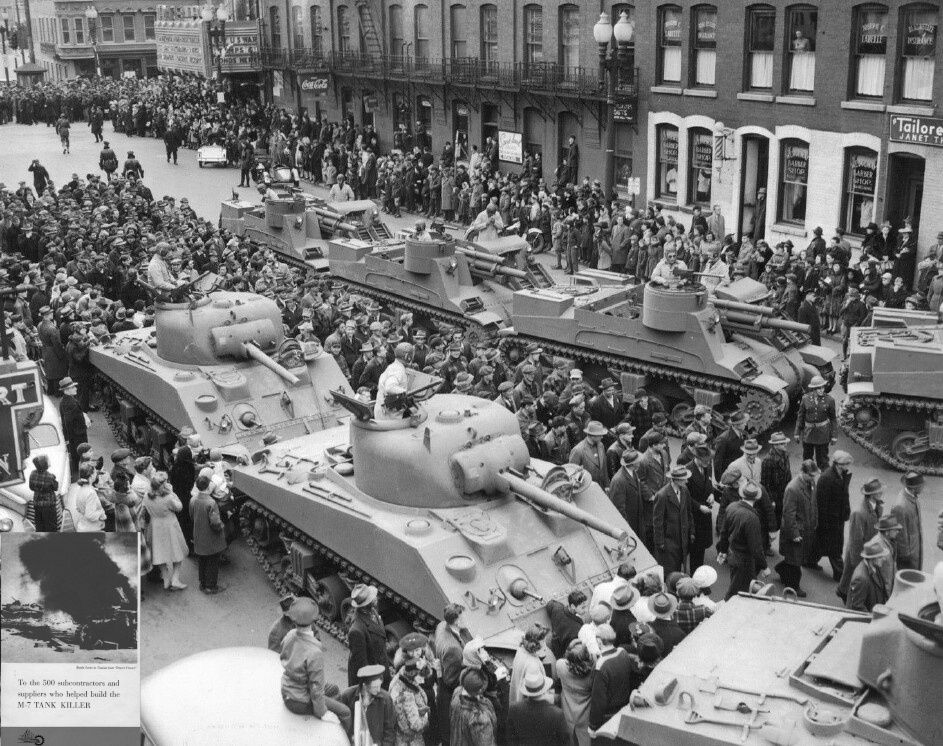
The people of Schenectady had a parade celebrating "M-7 Day" on 10 April
1943. "Col. Alan G. Cole brought the thanks of the British armed
forces, Maj. Gen. Russell L. Maxwell, U.S. commander in the Middle East
reported briefly on the effectiveness of the tank killers, and the
afternoon was climaxed by the first U.S. showing of the British
documentary film, "Desert Victory." ALCO really latched on to the idea
that the M7 was a tank killer more than what it actually was - an
effective self-propelled artillery piece. The pamphlet (inset) that
marked the occasion is entitled "To the 500 subcontractors and suppliers
that helped build the M-7 TANK KILLER." The main photo is in the
pamphlet and since we know that the date was 10 April, we get an idea of
the appearance of recently produced ALCO M7s and M4s. For the Priests,
deep pulpits, plain sprockets, original type grouser boxes and canvas
cover support frames are evident. Again, we have the use of both M3 and
M4 bogies. Each of the Priests can be seen with an engine crank
installed on the lid of the right stowage bin and a track wrench mounted
on the left bin. Oddly, while the official anti-aircraft weapon of both
the Priest and Sherman was the "Caliber .50 Machine Gun M2", the units
seen are armed with .30 caliber Brownings. In the upper left of the
photo one can see, "Workers of ALCO entering theater to see premiere of
"Desert Victory."" For a little historical context, this scene was
filmed about a month before the end of the Tunisian Campaign.
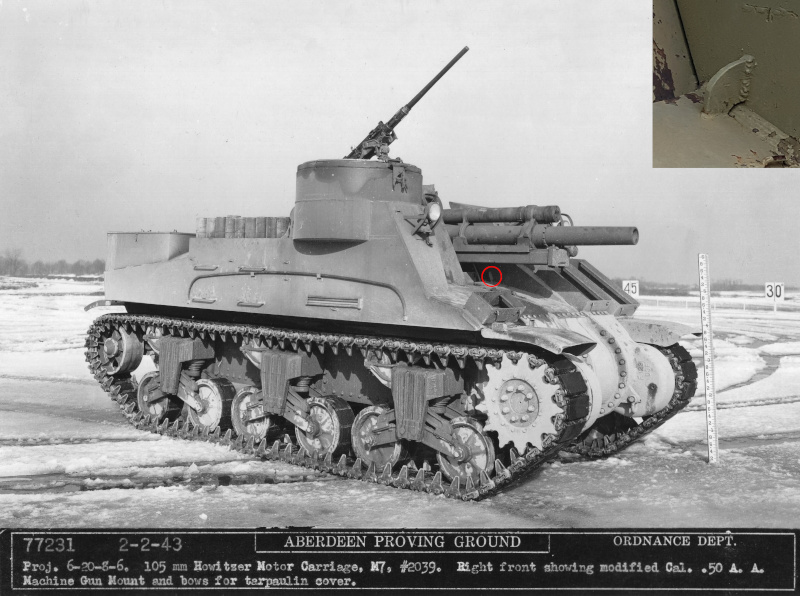
Here we have an APG photo dated 2 February 1943 showing Serial Number
2039, a January 1943 production M7. With the exception of the bogies, we
would judge that this unit pretty much reflects the appearance of M7s
built from January to August 1943 when production was suspended until
March 1944. Again, the M4 bogies seen here have the asymmetrical track
skids and lack the spacer modification. The bogie arms are in the early
configuration without the "wrench holes." We don't have enough data for a
good head count, but we can observe that "deep" pulpit M7s produced in
1943 are consistently seen with 3-piece differential housings. And we
might speculate that the use of M4 bogies may have become more
commonplace in 1943, possibly because the supply of M3 bogies was drying
up. Counting heads suggests that at some point in late 1942 or early
1943, a little support piece or gusset (circled and inset) was added to
the superstructure below the gun. This does not appear to have been part
of the original design, although it is seen on a few of the surviving
1942 production M7s. However, in those cases, we would guess that it was
retrofitted during rebuild.
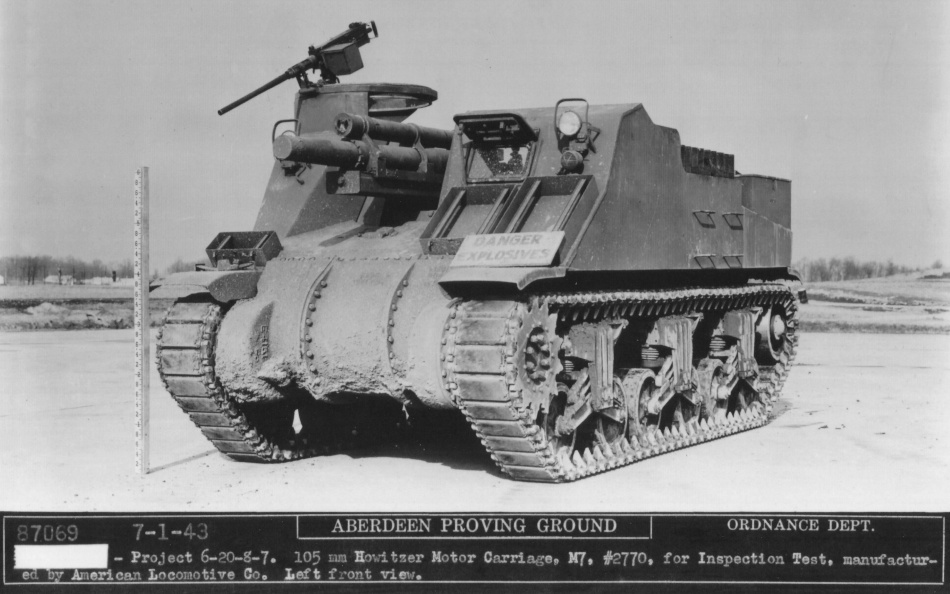
In general, we have found the Ordnance type photos to be
reasonably accurate and "trustworthy" for counting heads. However, this
APG photo kind of threw us a bit. It shows what is described as Serial
Number 2770 indicating that it would have been one of the last 68 M7s
built in August 1943 before the "break." However, the photo has an
earlier date "7-1-43", which, in the US, is taken to mean
"month/day/year" or July 1, 1943. But contradicting that is that the
background reflects a winter appearance in the state of Maryland. We
wondered about all of that since this M7 does not have the support
frames for the canvas cover installed. It seems likely that there is a
typo or two here; that is, we doubt if this photo was taken in July
1943, and we doubt if the M7 was SN 2770.
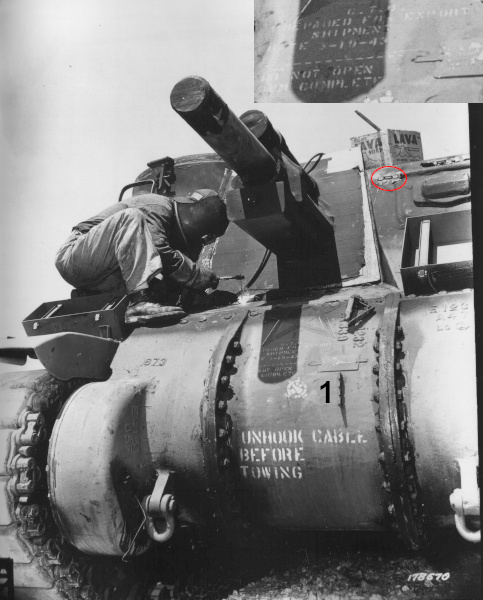
We don't have a copy of it, but "M7 Field Service Modification Work
Order G128-W15 Canvas Top" is listed in the "This Month's Directives"
section of the April 1944 issue of "Army Motors." We suspect that this
modification was applied months earlier than that to M7s headed
overseas, particularly to those shipped to the UK before D-Day. The
Signal Corps photo above is dated September 1943 and captioned, "His
identity almost hidden by his welder's helmet, Ray Heckman, who went
into war work immediately after Pearl Harbor, does a modification job on
an M-7 tank destroyer." (Again, with the "tank destroyer" nonsense.)
"C.T.D. Prepared For Export Shipment Date ?-19-43" (inset) can be seen stenciled
on the middle section of the 3-piece differential housing, which would
suggest that Mr. Heckman was working at the Chester Tank Depot. Judging
by the scorch marks (circled) around the footman loops, we believe Ray
was adding these as part of the "Canvas Top" modification. On this
example, the comb device (1) is mounted, and there is a "zinc tag"
affixed just above upon which was stamped instructions on how to use the
comb. In the event that handlers did not see or read the zinc tag,
"UNHOOK CABLE BEFORE TOWING" was prominently stenciled on as well.
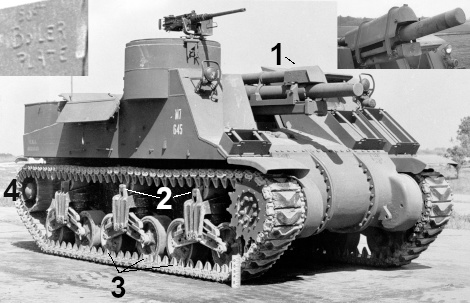
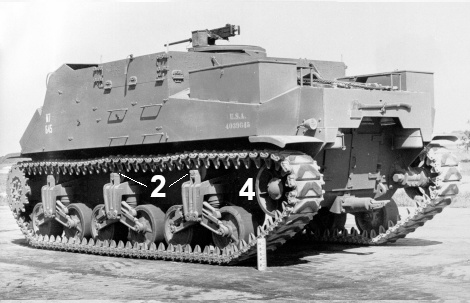
"Field Service Modification Work Order G128-W25" was released on 16
September 1943 "To provide folding auxiliary armor plate to protect
ammunition and crew." This applied to Priests built on M3 Medium
chassis, that is, "M7s having serial numbers from 3 to 2816 inclusive,
[and] which are located outside the continental limits of the United
States." The implication here is that the folding plates were not
factory installed on any of the M7s built by ALCO up through August
1943. The photos above presumably show a test installation of the
modification using "Soft Boiler Plate" (inset), but that strikes us as
odd considering that the information panels for these APG photos are
dated "8-8-44" [August 8, 1944] almost a year after the modification was
released. In addition, the folding armor plates were factory installed
starting in March 1944, so August seems a bit late for a soft plate test
of the mod. Perhaps the wrong year was typed in? No Serial Number is
given but the M7 can be seen as USA 4039645 indicating July 1943
acceptance. The info panels have only a terse description "Experimental
components." Perhaps in August 1944 the M7 was being used to test the
"armor protection for recoil cylinder"? Readers might recall that along
with the folding armor modification, the officers of CCB, 1st AD in
Tunisia recommended that "An armor plate shield should be installed to
protect the forward end of the recoil cylinder." Note the "Boiler Plate"
cap (1) over the recoil cylinder. OCM 23712 dated 4 May 1944 "Approves
development of armor protection for recoil cylinder" but as far as we
can tell, this cap was never factory installed on any M7 series or
introduced as a modification. The same can be said of a more elaborate
"Recuperator Shield" photographed at APG in Sept. 1944 and shown in the
inset. Another modification seen here involves a change to the original
grouser boxes. Note how small plates with rounded corners have been
welded on to the boxes. The plates can be seen with additional pairs of
retaining bar holes mounted further inboard than the original holes.
This appears to have been done to permit track blocks with end
connectors to be secured, instead of, or along with grousers. Another
modification that can be seen here is the addition of the spacers (2)
designed to raise the rollers up by about an inch. While ALCO used
either welded spoked or pressed metal spoked (3) road wheels in
production, we don't find evidence that the company procured supplies of
pressed metal idlers. It was found that the welded spoke idlers (4)
gave trouble, and the Ordnance Department mandated the use of pressed metal
idlers ("Idler Wheel C85164") on "Medium Tank M4 Series" vehicles with
"No tanks without this item to be accepted after 9/1/43 [Sept. 1,
1943]." In any case, it is thought that all M7s produced in 1942 and
1943 were built with welded spoked idlers, while all M7 series produced
in 1944 and 1945 were built with pressed metal spoked idlers.
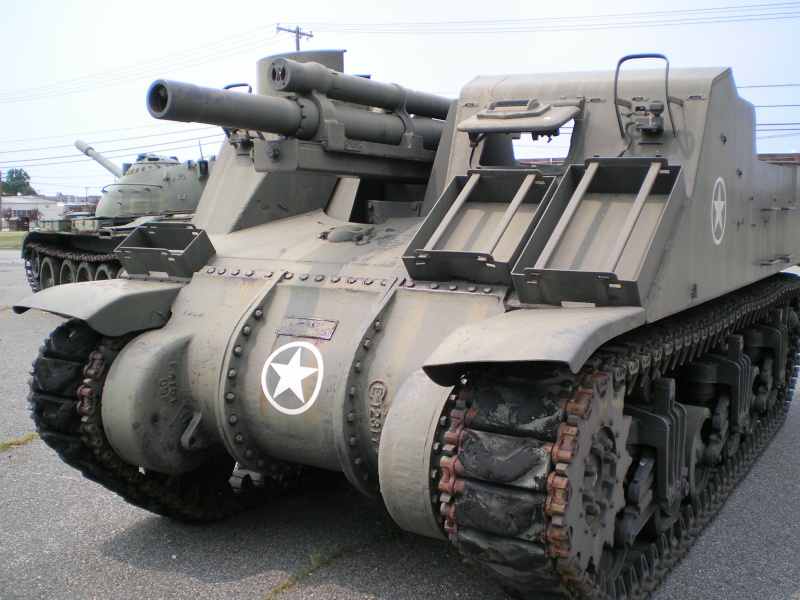
Here we have a photo of M7 SN 2623 (June 1943 production) that "showed
up" at APG in 2007. It would appear that it had been in storage in the
"restricted area" for many years. We were happy to have had an
opportunity to examine it because, of the 30 or so surviving 1942/43
ALCO M7s, this one strikes us as being closest to "as built" condition.
For instance, at the time we saw it, it still had its original M3 Medium
type instrument panel more or less intact (inset), whereas the original
panels were removed from most of the other survivors and replaced with
"tombstone" panels when the engines were replaced in the course of
service. During WW II, SN 2623 served as a test tank at APG, and was
shipped up to Minneapolis in late 1943 or early 1944 along with a number
of Shermans which were used in "Winterization Tests". In any case, it
can be seen with the small plates with rounded corners welded on to the
grouser boxes. For counting heads purposes, we refer to this
configuration as "grouser box mod 1". Due to a lack of factory photos,
we have not been able to determine if this was ever installed by ALCO
during the assembly process. If it was, we suspect it was not done until
the summer of 1943. However, we can't help but think that it was also
retrofitted to many earlier production M7s as a modification. A very
limited "counting heads" suggests that the "new" grouser boxes appear in
a few photos of M7s in the US starting around mid-1943, and in overseas
"combat" photos dated 1944 or later and showing M7s in all of the major
theaters: ETO, MTO, PTO and CBI. They are observed on some examples
with shallow pulpits, which would lead us to think that they were
retrofitted. We haven't found any evidence that a Modification Work
Order with "aftermarket" parts was provided. The very standard nature of
the added pieces would lead us to think that they would have to have
been mass-produced and welded on to the grouser boxes using some sort of
“production line” assembly method with jigs and such. Therefore, we
would guess that they were retrofitted as part of a Tank Depot
directive. Not long after we looked at SN 2623, the Ordnance Museum at
APG was permanently closed and the armor collection was scattered
throughout the US. Pierre-Olivier reports that he saw SN 2623 in storage
at Ft. Sill in 2023.

Above is one of a series of photos showing gunners of the 62ème Régiment
d'Artillerie d'Afrique, 5ème Division Blindée lined up for an
inspection in the Maâmora forest in Morocco sometime during the month of
October 1943. This is the earliest instance of the mod 1 grouser box
configuration we have encountered in an overseas photo. It can be seen
on numbers 1, 2 and 4, with 3 having the original boxes. In May 1943,
the 62ème RAA was organized as an Armored Artillery Regiment organic to
the 5ème DB. The 62ème RAA exchanged its old French 75mm guns for 54 M7s
starting in early October 1943. It is thought that the inspection
photos were taken shortly after the unit was issued M7s. Some of the
Priests in this photo series are seen with "C.T.D." [Chester Tank Depot]
stencils and/or the "comb" devices typical of CTD, so perhaps the
grouser box modification was done there during processing for shipment?
The 62ème RAA continued training in northwest Africa for nearly a year
before being deployed to southern France, landing at Saint Raphaël on 21
September 1944. The regiment fired its first combat missions on 3
November 1944 in the area of Remiremont in the foothills of the Vosges
mountains. Photo courtesy of ECPAD, TERRE 111-2229.

This photo shows what we think of as "grouser box mod 2" on the two
larger boxes as seen on SN 179 (July 1942 production) on display at the
Museo della Motorizzazione Militare della Cecchignola in Rome. This was a
much simpler modification only requiring the addition of footman loops
to the top edges of the original grouser boxes. These are seen in enough
period photos to lead us to think that they may have been retrofitted
based on instructions provided in something like a Technical Bulletin.
The smaller box can be seen in the "mod 1" configuration. (We don't know
of any surviving M7s on which all of the grouser boxes are "mod 2".) As
mentioned previously, SN 179 was rebuilt in Italy, so, for instance,
its original M3 Medium instrument panel was replaced with a tombstone
type of panel which appears to have been one of the extra components
supplied with replacement engines. We don't see evidence that the
retaining bars were originally secured with chains as seen here, so
suspect that they were added by the Italians.
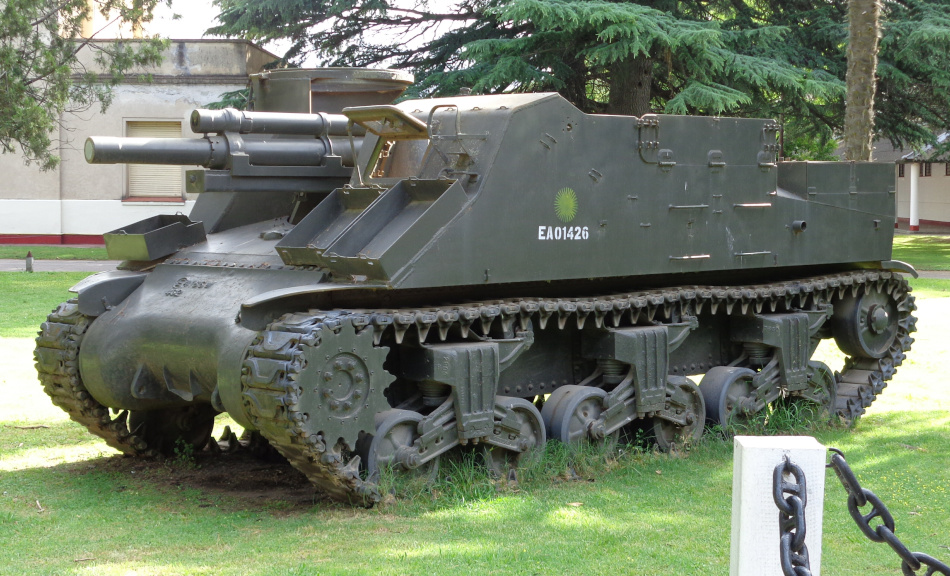
This M7 is SN 196 (July 1942 production) on display at the base of
the Regimiento 10 de Caballería de Tanques in Azul, Argentina. It has
what we think of as "grouser box mod 3". This configuration is the most
common seen on the 30 or so surviving 1942/43 production ALCO M7s, with
11 examples observed. It is similar to "mod 2" with the footman loops,
but the smaller box was replaced with one that appears to be much wider
from front to back and a bit taller than the original. The notched-out
corner may have had to do with an interference issue when the gun was
depressed. We can't help but think that there was a reason for replacing
the original 3 grouser box but have not as yet come across any
documentation. We suspect that this configuration was done during an
informal rebuild program in 1944. It has been noted in a few overseas
photos of M7s taken in 1945 in the Pacific Theater. About half of the
surviving examples with this configuration are also installed with
blanket baskets on the rear stowage bins. All of the M4 bogies on SN 196
have the final type of track skid introduced in Sherman production in
early 1943. These would not have been original to a July 1942 production
M7 and would lead us to assume that the bogies were retrofitted during a
rebuild. Indeed, one of the bogies has the date "11-43" cast on its
face. The original differential housing and transmission appear to have
been replaced with a unit from an M10 Tank Destroyer, but Jim Goetz was
not able to discern the M10's Serial Number on the front towing lugs. A
sign near the M7 lists a chronological history of the Grupo de
Artilleria Blindado 1. Regarding the M7 it simply states that in 1959
the unit was equipped with M7s. These don't seem to have been obtained
as military assistance from the US. Jim saw four M7s during his tour of
Argentina, and all of them had obviously been re-engined. According to
the Sherman Register, "Six M7 105 mm HMCs arrived in 1950. Years later
they were taken out of service until 1981, when they were modernised for
return to active duty. Engine: Deutz F10 L-413F 450 hp air cooled
diesel engine."
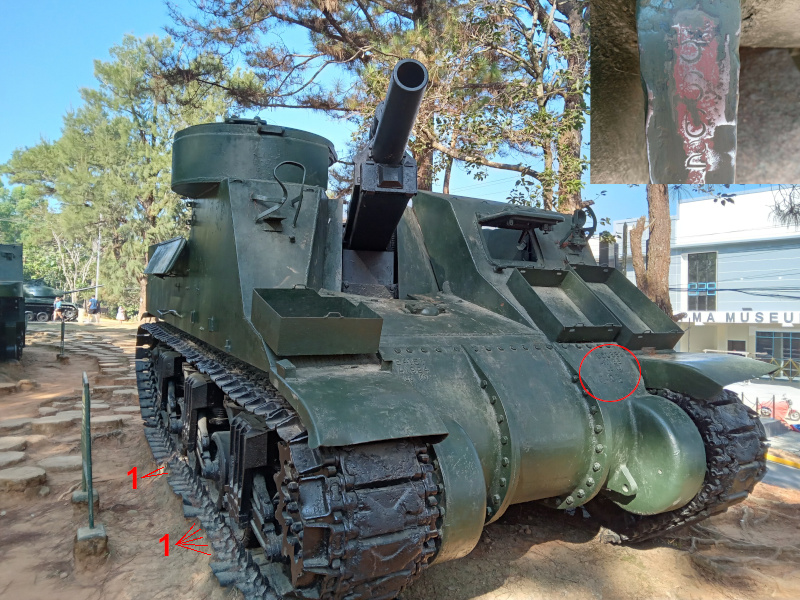
Jim visited another M7 that is in the "grouser box mod 3" configuration
at the Philippine Military Academy in Baguio, Luzon. Jim recorded SN 958
from the left rear towing lug which would indicate that this M7 was
produced in November 1942. Note how the notched grouser box has no
holes, just the footman loops. This is one of the few surviving Priests
that is installed with extended end connectors. It can be seen that some
of the EECs have broken off (1), which is frequently observed in
period photos. As with SN 196 in Azul, this unit has had its original
bogies replaced with the M4 type with the "final" version track skids.
Also, like the Azul, the original differential housing and transmission
was replaced. Jim found "5662" (inset) stamped on the right front towing
lug. That SN would correspond to an October 1942 production M4A4. Note
that the diff sections do not have the protective "lips" in front of the
bolts running across the top. From our counting heads study of M4A4s,
we have determined that the lips were added to the castings made for
Chrysler starting in December 1942. In addition, some early M4A4s have
been noted with an alternate Part Number D50993 (circled) on the left
diff section as opposed to the usual E1231 PN. There is no evidence that
any M4A4s served in the Philippines, which would lead us to think that
the differential housing was added as a replacement during an informal
rebuild program in the US in 1944. As mentioned, the "grouser box mod 3"
configuration has been noted in a few overseas photos of M7s taken in
1945 in the Pacific Theater. Although this M7 does not show evidence of
having been installed with wading trunks, we would not be surprised to
learn that it had served with US forces in the PTO.
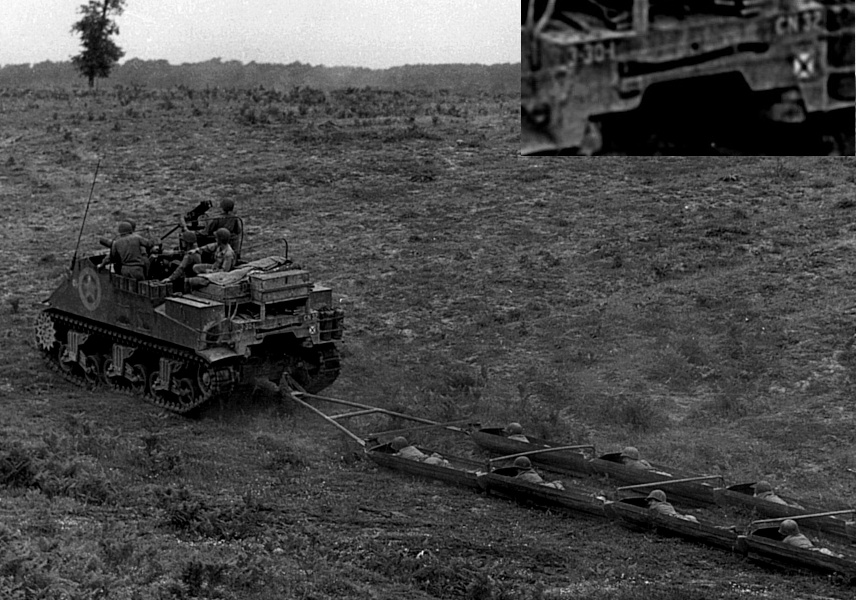
Returning to the Italian Theater, as a result of skillful planning
including effective deception measures, the Allied Spring Offensive of
May 1944 caught the Germans off guard. In the south, both the Gustav
Line and the fallback position at the Hitler Line were breached. This
success enabled the reinforced VI Corps at Anzio to break out of the
perimeter after 5 months of stalemate. Rome fell on 4th June. By August,
the Germans were forced back to their "final" prepared position, the
Gothic Line, which ran roughly from just north of Pisa on the west coast
to Pesaro on the east coast. On 9 May 1944, a few weeks before the
Anzio breakout offensive, Gen. John O'Daniel, commander of the 3rd
Infantry Division, put on a demonstration of his "battle sled"
invention, which was basically half of a torpedo shell capable of
holding an individual soldier lying prone. Twelve of the sleds were
combined to be pulled into combat by a medium tank, or in the case
demonstrated above, an M7. The 3 Infantry Regiments of the 3rd ID each
organized and trained "battle sled teams" of 60 men. Several platoons of
Shermans of the 751st Tank Battalion were equipped to tow the battle
sled devices. The 7th Infantry Regiment abandoned their sleds,
apparently because the towing tanks encountered an uncharted mine field
right at the start line. The sleds of the 30th IR fared no better as
they had to be unhitched after traveling a short distance when the
towing tanks encountered a mine field on the Ponte Rotto-Cisterna Road.
"The tanks were later sent on another mission and did not use the battle
sleds thereafter." The 60-man battle sled team of the 15th IR was towed
to within 300 yards of their objective where the tanks were stopped by
an impassable drainage ditch. A number of casualties were suffered by
the infantry when the enemy laid down an intense mortar barrage. Two
houses (the objective) were destroyed by the tanks permitting the
infantry to advance and take their objective. "Thus ended the first and,
as it turned out, sole test of the division commander's proud
innovation." The 751st TB report simply states "Our experience with the
use of the Battle Sled was not very satisfactory. A tank moving cross
country must of necessity be free to maneuver. Various obstacles are
generally encountered requiring the tanks to back up or make sharp turns
which is not possible it they are towing Battle Sleds." In the photo,
the M7 can be seen with the tactical markings "3-30-I...CN 32" (inset)
which we take to mean Cannon Company, 30th Infantry Regiment, 3rd ID.
The July 1943 TO & E authorized 6 towed M3 105mm howitzers to the
Regimental Cannon Company, but it is obvious from photos such as this
that some companies were equipped with at least some M7 Priests. This
example sports an antenna, suggesting it was installed with a radio.
Another photo shows this Priest with a shallow pulpit but note the
support frames for the canvas cover. We suspect this might have been
retrofitted as a field modification.

The entire US 1st Armored Division was eventually deployed to Anzio and
played a key role in the breakout offensive. The photo above is dated 16
September 1944 and shows a pair of M7s near Lucca, Italy conducting a
fire mission on a Gothic Line target to the north. The Priest can be
seen with the name "Mable" but is otherwise unidentified. However, the
soldier talking on the phone, presumed to be the M7's "Chief of
Section", can be seen with the 1st AD shoulder patch. The USA
Registration Number is visible as 3034648 (inset) indicating August 1942
acceptance. This appears to be a case where the RN was "welded on" so
that the vehicle could be identified even if it burned, and the
painted-on RN was obliterated. The 1st AD appears to have done this on
their tactical vehicles and AFVs whenever they were serviced or
repaired. Mable's RN is listed in the records of the 123rd Ordnance
Maintenance Battalion on 3 January 1945 as requiring an engine
replacement. The "Unit" that turned it in is noted as the "91st F.A."
Readers might recall that the Armored Field Artillery Battalions of the
1st AD were the 27th, 68th and 91st, each of which would have been
equipped with 18 M7s at full strength. Reading between the lines of the
123rd Ord's records, it would appear that the 3 Tank Battalions of the
1st AD, the 1st, 4th and 13th TBs, were equipped with M7s as "assault
guns" but that they were replaced with M4A3(105) Shermans in early 1945.
For what it is worth, of the 96 or so M7 Registration Numbers recorded
by the 123rd Ord., all but 3 are for units produced in 1942.
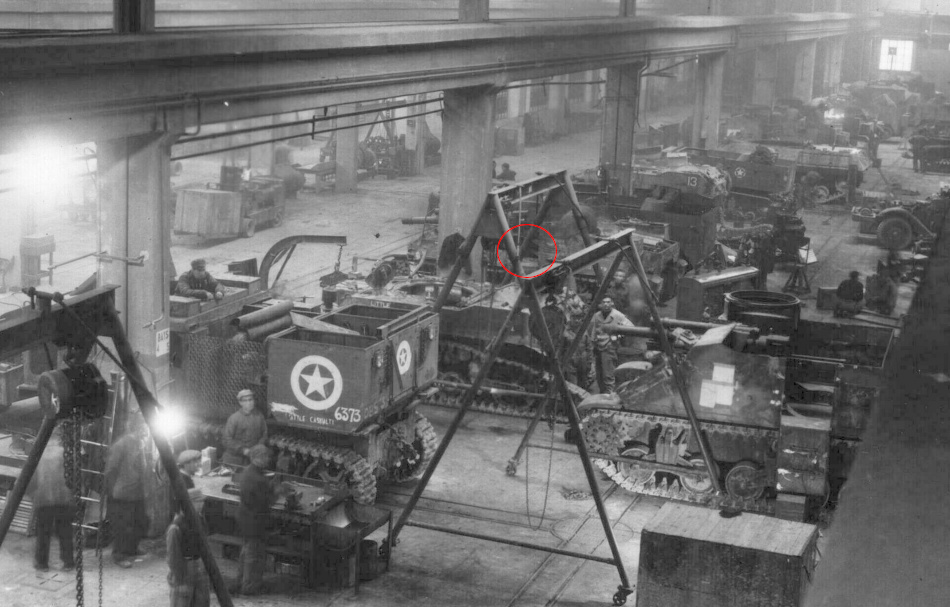
This Signal Corps photo is dated 6 February 1945 and was taken in the
"Leghorn [Livorno] Area". "All types of tanks and half tracks are in
various stages of repair in the Tank Repair Section of the PBS
[Peninsular Base Section] Base Ordnance Shop. Two of these vehicles are
turned out every day for renewed action at the front." The M7 in the
foreground can be seen with an interesting modification - a side door
hinged at the bottom. We must assume that this was added for easier
loading of 105mm ammunition and may have been inspired by the small side
door that was part of the design of the Sexton 25 Pounder
Self-Propelled Gun. It appears that the Priest had had armor plates
welded to the sides and rear, and that part of the left side plate was
cut out along with the original side armor to form the door. There is
another example of the retrofitted side door (circled) partially visible
in the middle of the photo and possibly another way in the back behind
the turretless M10. We don't know if this was done while the M7s were at
the Base Shop or earlier. It doesn't seem to have been a widespread
field modification, but we have seen similar retrofitted doors in a few
photos of M7s in the European Theater of Operations. At present we are
not aware of any surviving examples with this modification.

The Gothic Line bent but did not break until the Allied Spring Offensive
in April 1945. The photo above is captioned "29 April 45. Fifth Army,
Lake Garda Area, Italy. An M-7 of 'A' Battery, 1125th F.A. Bn., fires at
a road across Lake Garda, where German convoys have been moving north."
The German Army in Italy surrendered on 2 May, so this scene likely
depicts one of the last M7 fire missions in the MTO. The 1125th Armored
Field Artillery Battalion was a 5th Army asset made up of "several
inactivated antiaircraft artillery units...[re-equipped] with
self-propelled 105-mm. howitzers." Battery A was attached to the newly
arrived US 10th Mountain Division starting with their combat debut in
late February 1945 at the battle for Mount Belvedere. Mountain trained
units were highly valued by both sides during the Italian Campaign.
Indeed, the Allies' only such unit for the Spring 1944 Offensive, the
Corps Expéditionnaire Français, is acknowledged to have played the
pivotal role in breaking the Gustav Line. Albert Kesselring, overall
commander of German forces in Italy, had this to say of the 10th, “To my
surprise—in deep snow—the remarkably good American 10th Mountain
Division launched an attack against the left flank of [the German
defensive line], which speedily led to the loss of the dominating
heights of Monte Belvedere.” As seen here, some M7 crews created a
raised "shelf" (1) over the engine deck to hold their gear. The open end
of this construct (2) presumably permitted sufficient air to flow
through the "grille protecting covers." Readers might recall an earlier
caption about M7 SN 2537 on display at the "Musée des Epaves
Sous-Marines du Débarquement" in Port en Bessin. The M7 in the
foreground can be seen with brackets (circled) similar to those on SN
2537, suggesting that it had once been installed with a wading trunk.
PAGE 1/3
Go to page 2 Go to page 3
